



The word speculation is defined as ‘the forming of a theory or conjecture without firm evidence’. The act of speculating was predominantly popularised with the rise of the stock market, however, recent environmental destruction and technological advancements have prompted a rich pool of speculation about the future of our planet, our species and our connection to other facets of life. Tomorrows: Urban Fictions for Possible Futures is such an exhibition, compromised of imaginative narratives speculating the future of our cities – how they will look, how they will function and the degree by which these cities will form new types of citizens directly operating within the network of that future city. In the context of the exhibition’s content, fiction is transformed into mighty medium, utilised to share the ideas of thirty-two individual and group projects. These projects envision and share their anticipation for the future as a means of addressing socio-economic, environmental and other issues we face today with a goal to reassess of our presence on the planet.
Tomorrows was curated by Daphne Dragona and Panos Dragonas, and organised by the Onassis Cultural Centre in Athens – a city experiencing continual fluctuations since the end of World War II. The location itself, Diplarios School (a place of former learning and listening), stresses the aspect of sharing and the telling of important narratives determining the shaping of the future. The exhibition begins with a didactic, yet absolutely accessible approach to understanding the notion of developing a future city. As a starting point, the exhibition borrows and advances the ideas of Doxiadis’ speculative plans of an Ecumenopolis from 1959-1974. More particularly, we must take into consideration the term ‘ekistics’ which was coined by Doxiadis in 1942 as derived from the ancient Greek noun οίκιστής, meaning a person who installs settlers in a place or creates a settlement.
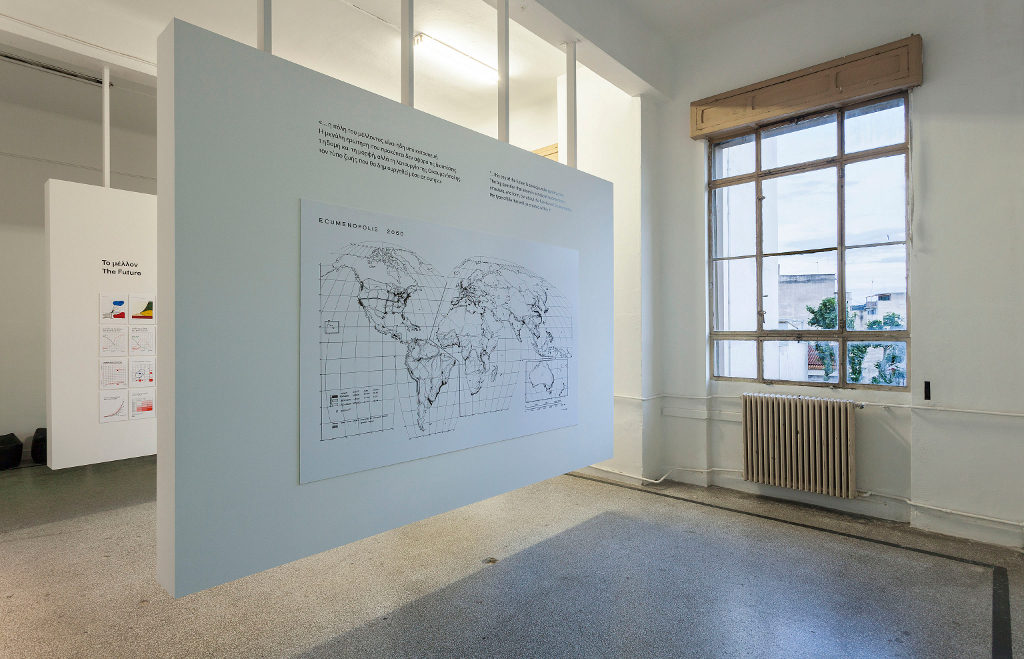
In order to create the cities of the future, we need to systematically develop a science of human settlements. This science, termed Ekistics, will take into consideration the principles man takes into account when building his settlements, as well as the evolution of human settlements through history in terms of size and quality. – Doxiadis
Doxiadis was a visionary and the decision to reinstate his work within the framework of the exhibition was incredibly rewarding for visiting audiences. He anticipated that cities were to become more than global in order to accommodate an ever changing human and non-human environment – as one huge network perhaps out of the control of human capacities. Ecumenopolis is installed on large hanging panels in the first room of Tomorrows and acts as a reference point to the five themes developed: Post-Natural Environments, Shells & Co-Habitats, Networks & Infrastructures, Algorithmic Society and Beyond Anthropos. These themes resonate to the acceleration of our urban development hybridising the natural with the artificial, future network infrastructures of our habitats becoming dependent on inhuman mediation, the possibility of an omnipresent and undemocratic structure within the city through the interdependence of economy, ecology and technology, possible forms of organisation to encourage modes of co-existence within the city, and technological singularity as challenging human sovereignty within our future cities. Doxiadis work gives way to the participants who are primarily artists, architects and designers, to explore these imminent futures of our present planet’s landscape.

Coastal Domains is an on-going research project exploring the future landscaping of coastal territories in the Northeastern Mediterranea facilitated by Demetra Katsota along with 4th and 5th year students at the Department of Architecture, University of Patras. The installation Coastal Domains was made up of sixteen books, acting as case studies, secured on the wall and a ladder to reach them, encouraging brave visitors to climb and read them – a curatorial decision simultaneously inspiring participation and learning as it is explicitly reminiscent of old archival libraries. The 7th book in the series of sixteen engaged with the coast land of Kanoni and its Sea Lane on the island of Corfu, the research undertaken by Stella Andronikou and Iasonas Giannopoulos. As with each book in the series, the research was made up historically archived material, such as cartographical maps from different centuries and topographical material including the arrangement of roads and different fauna on the island thus unveiling issues of coastal development, the implications of an upsurge of tourism in the 1970s and possible environmental issues. Coastal Domains speculates and designs possible structures for the reinforcement of sustainability, devising various strategies that can protect the coasts of the Mediterranean Sea.
Tomorrows is particularly involved in engaging its locality of the Mediterranean, treating it as a microcosm for observing the implications of the future’s development. Silo(e)scapes by Zenovia Toloudi envisages a hybrid of a seed bank and museum for Mediterranea plant species as a tool inspiring a sharing economy. The installation of Silo(e)scapes required the audience to cradle themselves into the centre of the structure in order to experience the transparent silos-displays of the community LEGO labourers sharing their local seeds at the seedbanks. The audience suddenly find themselves in a possible future reality, all encompassing of agrarian sounds and 360 views of kaleidoscopic mirrors that trick perception of your depth of field. Almost theatrical, Silo(e)scapes is immersive and constructs a space where the audience is directly in conflict with the imminent shortage of supplies due to harmful environmental issues and increasing urban development. The audience becomes entirely physically encased in Silo(e)scapes, as a result inciting the plausibility of this future reality.

A Cave for an Unknown Traveler by Aristide Antonas introduces another form of habitable landscape for the possible future. The installation is structured like a ‘fake archaic cave’ that is buries inside it a structure as luxurious as a modern hotel room, invisible to the eye from the outside. The installed structure of the cave is complimented by a large sketchbook denoting the various features of the Cave for an Unknown Traveler. Antonas’ work brings to mind the concept of Plato’s Allegory of the Cave. The infrastructure and services within Antonas’ cave can be taken in context of the prisoner’s in Plato’s cave perceiving shadows as objects when in fact they are a mere representation of their physical form grasped by our mind. In this context, Antonas’ invisible cave begins to resemble an imagined safe haven for a traveling passer-by.

The highlight of Tomorrows is undoubtedly Liam Young’s commissioned work Tomorrow’s Storeys – a two-channel video installation isolated in a dark room with modular seating. The title of the work acts with a double meaning as in storeys of a building and the stories being told through them. The content, or stories, narrated in Tomorrow’s Storeys were first conceived in a workshop in mid-March as part of the programming to the run-up of the exhibition opening in mid-May. The workshop of visual artists, authors, photographers, directors and architects produced an abundance of local stories in the future city of Athens, particularly a future Athenian apartment block. In Tomorrows Storeys all apartments blocks have the ability to reorganise themselves automatically – modular entities like seating in the installation. The videos convey intricately detailed shots of the façade of these apartments as well as its contents recalling film shot by aerial drones and ads for IKEA products. The audience act as omnipresent eavesdroppers drifting from storey to storey into the conversations and local happenings in these apartment blocks. These apartment blocks of the future have found a way to reorganise themselves where Athenians are not given a minimum basic income but instead a minimum basic floor area – the occupants do not own an apartment but a specific volume of space which does not have a fixed location. Amongst these stories of shifting permanence and impermanence one stood out: that of an old grandmother dying and the family arguing about who takes over her volume of space as one character cries quite humorously “Can’t you wait until the funeral?!”. Tomorrows Storeys are part of a city where bots constantly reorganise your living in a form of urban computation according to best fit the needs of its citizens. In this way, a living space becomes a temporality, alluding the audience to question if their home is real if it always available for smooth transition to another space.

Within urban infrastructures are the human entities contained within them, as Young’s work emphasises, however some of these are becoming increasingly inhuman as the theme of ‘Beyond Anthropos’ suggests. The notion of inhuman or machinic entities being able to replicate human form and intelligence is common and highly popularised since the 1980s as films such as Bladerunner introduced global audiences to ‘replicas’. Today, AI is becoming so intelligent that it urges inventors such as SpaceX and Tesla CEO/founder Elon Musk to warn for correct precautions to be taken when engaging with AI, in fact comparing it to ‘summoning the demon’ and naming it ‘our biggest existential threat’ in the 2014 AeroAstro 1914-2014 Centennial Symposium by MIT. The work of !Mediengruppe Bitnik, coming only a couple of years after Musk’s interview, exemplify the relationship between human and machine. Ashley Madison Angels at Work in Athens is a research project initiated after the data of the Canadian online dating service was leaked in 2015. The leak revealed that Ashley Madison had created 75,000 female chatbots that catered to 32 million mostly male users, engaging them in costly internet intimacy. In Athens, there were 165 fembots for around 22,910 registered users. The installation was comprised of seven of these 165 fembots active in Athens, and were installed in a room dimmed by a fluorescent pink light with screens on tripods similar to average human height and alluding to a physical form. The fembots, programmed to be of different ages, utter pick-up lines they are allocated from a predetermined list to the 22,910 registered users who could not distinguish that they were talking to a machine and not a real person.

Tomorrows does not wish to present us a future as a prediction or as a form of critique of these technological, environmental and urban developments. Rather, it presents the future as an on-going participatory project, as a tool that can be utilised to examine who we are and where we are at in present tense, as well as where we could be potentially going. These urban fictions of our possible futures, are a speculative activity with the capability of making us more aware of the changes that have taken place whilst simultaneously illustrating the changes that are afoot. Tomorrows was a show that took place over six months ago, but its value to the discourse of the future will remain timeless for decades to come.
“[A] hundred reasons present themselves, each drowning the voice of the others.” (Wittgenstein, Philosophical Investigations: supra note 11 § 478).
For Part 1 click HERE.
For Part 2 click HERE.
Voice and unintelligibility play a greater, complex role in reasoning than the Left or Right accelerationists are prepared to admit, or fail to see. Establishing ones political voice is far broader and extensive than any of these thinkers take it to be, and is not simply the by-product of a phenomenological given unable to envisage any political alternative. Voice has to take priority here, for how else does one actually communicate? By this, we don’t have to take Voice to be the literal act of saying something out loud, or examining the behaviour for doing so. It can interpreted both as a metaphor and means encompassing every political act to which it can be applied; having a voice, or an opinion, hearing the public representation of someone, or of a community, wanting to being heard, letting someone have a say in the matter, etc. Above all it takes on the force of voicing ones own condition.
Might every form of modern communication then, be it a WhatsApp message, a bored glance at a meeting, cynical internet comments to nondescript mumbling, be one of ordinarily voicing our own condition? Perhaps even more so when it is mediated by an infrastructure (sometimes especially so). Both Voice and infrastructure are components of communicating indirectly, as most language games tend to do, whether face to face, face to mirror or interface.
The problem with philosophy is that the ordinary gets blamed, largely as the historical list of philosophy’s complaints almost always aim for the ordinary first as if its triviality is, by itself, not to be trusted with political or rational action. Indeed the very task of calling the ordinary to our attention, takes into account that we have lost interest in it. Perhaps it was already assumed that the market silently reduces the depth of ordinary communication and circumstance to capitalist knowledge anyway. Or maybe since ordinary life is increasingly and consistently mediated through online platforms, technology has overtaken its significance.
Yet what Ordinaryism seeks to uncover is that Voice does not constrain freedom because of its vulnerability: it is only because of vulnerability that voice expresses the freedom to reason in the first place. This is the split that severs both the sovereign rationality of Accelerationism (and Sellars), and the non-sovereign self of Ordinaryism (and Cavell). Indeed, this appears to be Cavell’s political lesson: it seems rational to want build a platform for others to air their democratic voice and decry any ineffective basis in favour something more determinate, more grounded, more inhuman. Yet freedom and justice only begins if a community is capable of ‘finding’ their own voice in the face of injustice. Likewise freedom is constrained if other voices repudiate the voice of others. There is no cognitive purchase for this, and no pre-built, implicit, or explicit ground for determining intelligibility either. So we have to ask, how else can the inhuman make itself intelligible unless it gives voice to its own condition? (As an aside, what else is philosophy but a set of specific and singular voices crying out for recognition in their appeal? A voice that may be acknowledged, yet equally repudiated? Just as the sound and look of Voice matter in reasoning, [how it persuades, how it strikes you] so too does the sound and look matter to philosophising arguments and deductions.)

The easiest way to round these political concerns up is to show how the very need to bypass the vulnerability of Voice, the need to provide an ‘answer’ or ‘solution’ to that vulnerability, is the same philosophical question that concerns solving skepticism. This is the heart of Cavell’s philosophy.
Following Naomi Scheman, the heart of transcendental inhumanism to which the epistemic accelerationists follow aims to draw attention to what underlies the possibility of our ordinary lives. But in Ordinaryism, the Cavellian rejoinder must insist that “the ordinariness of our lives cannot be taken for granted; skepticism looms as the modus tollens of the transcendentalist’s modus ponens.” (Scheman, “A Storied World”, In Stanley Cavell and Literary Studies, 2011 p.99). Whereas Accelerationism posits a renewed set of tools to re-determine intelligibility in an era of supposed ‘full automation’, Ordinaryism speaks to these same conditions but where intelligibility routinely breaks down, is endlessly brittle, always delicate, sometimes connects, but is never ensured or determined by philosophical explanation alone. What might it mean to understand the fragmented world of machines as a uniquely literary responsibility?
In other words, a future world of increased automation needs a romantic alternative. And it is sorely needed, because in this future order where automation is assumed to outpace human knowledge, or supersede it in any case (amplifying existing industries, or creating new ones) Ordinaryism speaks of new moments of doubt which constitute the skeptical fragments of ordinary life with machines. Perhaps also of machines. It might take on a specific personal form of questioning and living with what these new forms takes on; “what does this foreign mapping of data really know about me”, “what does it know about all of us?”, “Am I just being used here?”, “How can I know whether anyone is spying on me?”, “why are they ignoring me?”, “what on earth does that Tweet mean?”, “what’s happening?”, “what am I supposed to think about this”, “Why would I care about you’re doing?”, “I need to know what they’re doing.”
There are innumerable ordinary circumstances where a life with machines begins to make sense, but also starts to break down in all the same places: how might one suggest that a machine “knows” what it’s doing, or that “it knows” what to do? Where does the scalability of automated systems start to break down, and what sort of skepticism does it engender when it does? What happens when software bugs, and unpredictable acts of mis-texting chagrin habitual pattern? How might such finite points of knowledge exist, so as to understand and inhabit systemic doubt? What are the singular and specific means for how such systems are built, conceived or decided? And most of all, how might we even begin to characterise and acknowledge the voices which emerge within these systems? You might say that Ordinaryism wishes to extract acknowledgement out of the knowledge economy.
What is required then, is both a Cavellian critique of epistemic accelerationism (what potential political dangers might arise if Voice is repudiated) and why its solutions to solve skepticism through collective reasoning and self-mastery are no different from skepticism itself. But to do that, one also has to take account of how Cavell brings an alternate approach to imagining how normative rules are implicit in practice. This is not an act of opposition, more of a therapy, which might be needed, especially as politics is involved.
Now, despite the fact that Cavell’s philosophical questions work (almost) exclusively in the Wittgensteinian domain of articulating and expressing normative concepts which regulate speech and pragmatic action (beginning from his first essays Must We Mean What We Say? and his later magnum opus, The Claim of Reason) these texts don’t appear to be required reading in accelerationist and neo-rationalist circles.
Take the newly released art journal Glass Bead, whose aim is to suggest that any “…claim concerning the efficacy of art – its capacity, beyond either it’s representational function or its affectivity, to make changes in the way we think of the world and act on it – first demands a renewed understanding of reason itself.” If such a change in thinking is motivated by a renewed post-analytic approach to reason in a world of complexity (and an additional capacity for aesthetic efficacy), the continued omission of Cavell’s work into reason and aesthetics, is notable by its complete and utter absence. It’s enough to warrant the claim that certain imaginings of reason – in this case the abstract inferential game of giving and asking for reasons – are to be favoured over other types (usually with a secondary, pragmatist demand that science is the only authentic means for understanding the significance of the everyday).
In fact there’s a good reason for that omission: because Cavell discovered that he wasn’t able to ignore the threat of skepticism entirely, and instead discover it to be a truth of human rationality (is there anything more paradoxical than discovering ‘a truth’ in skepticism?). He instead sought to articulate how such concepts were not inherent features of inhuman ascension by means of inferential connection, but fragmented conditions of differentiated identity. In the eyes of the epistemic accelerationist, it’s as if there isn’t any possible option in-between some half-baked, progressive ramified global plan to expand the knowledge of human rationality, and a regressive fawning over the immediacy of sensual intuition. Fortunately, Cavell’s ‘projective’ approach to rationality questions this corrosive forced choice.
Wittgenstein’s Philosophical Investigations sets up the key differences here. Instead of using Wittgenstein’s text as an introductory tool to show how the public expression of saying something can be explained and correctly applied (as Robert Brandom pedantically attempts), Cavell paid attention to Wittgenstein’s voice, as it invokes a specific and personal literary response to what happens when we are in search of such explanatory grounds (and how they always disappoint us). Perhaps more pertinently, Wittgenstein alluded towards an effort ‘to investigate the cost of our continuous temptation to knowledge.‘ (Cavell, The Claim of Reason, p. 241) Compare this to the current neo-rational appeal which has little to no awareness that the pursuit of certain knowledge (and the unacknowledged consequences for when it will go astray) might itself be inherently unproblematic. Because reason presumably.
It’s no accident therefore that Philosophical Investigations has become one of the oddest literary feats in Western philosophy, insofar that it presents itself as a personal account, rather than a systematic one. Cavell was not only the first to prise out a Kantian insight from Wittgenstein’s text, but also to ask the simple question of why does he write like this? It’s as if every single word, every ordinary word, now takes on the full power and insight as any theoretical term of jargon: as if a theoretical vocabulary isn’t wanted or needed. Why does Wittgenstein provide provocative literary fragments to elucidate his philosophical struggles? (the infamous ‘mental cramps’) Why does he raise literary devices to flag up disappointing conclusions: where a rose possesses teeth, beetles languish in boxes, and lions speak in packs of darkness? It’s an insight which lies in acknowledging that Wittgenstein’s unique literary voice is inseparable from his philosophical ambitions. It is not that he offers an anti-skeptical account to fully fix and explain what it means to say something: nor does he posit an implicit mastering of normative concepts, whereupon said possibilities are subject to further explanation (the conditions under which cognition or experience become possible).
It’s as if the theoretical problem doesn’t come with fully understanding norms implicit in practice, but the very situation in which using words like “rules”, “freedom”, “determine”, “correct” and so on, do not have the desired theoretical effect (in the accelerationist case, freedom). These are very nice words after all, but the neo-pragmatist theory is found wanting in their full expression, sufficient to the limits given when they are spoken not as a licensed inference, but as a creative effect. Cavell’s take on language thus, is that there is always something more to words than the current practice in which they are put to use.
The appeal to Wittgenstein’s literary conditions is what motivates Cavell to suppose that his theory of norms in practice isn’t something to which words are used to line up a certain conclusion, rather, the specfic and singular non-formal ordering of ordinary words in themselves provide a certain crispness and perspicuity, as well as difficulty and confusion. As Paul Grimstad suggests:
“Cavell wonders what one would have to do to words to get out of them a certain kind of clarity; to ground their meaning in an order. A kind of literary tact—the soundof these words in this order—would then serve as the condition under which we are entitled to mean in our own, and find meaning in another’s, words. The sort of perspicacity striven for here is not a matter of lining up reasons (it would not be “formal” in the way that a proof is formal), but of an attunement to arrangements of words in specific contexts.”
As Sandra Laugier chooses to describe it, Cavell’s posing of the Ordinary Language Philosopher’s question – “What we mean when we say” arises from “what allows Austin and [the later] Wittgenstein to say what they say about what we say?” For Cavell jointly discovered a radical absence of foundation to the claims of ‘what we say’, and further still, that this absence wasn’t the mark of any lack in logical rigour or of rational certainty in the normative procedures that regulate such claims. (Laugier, Why we need Ordinary Language Philosophy – p.81)
If agreement in normative rules becomes the presupposition of mutual intelligibility, then any individual is also committed to certain consequences whereupon certain rules might fail to be intelligible. Therein lies a simple difference: the espousal of following a universally applicable rule (as Brassier holds) and everyone else wondering whether that same rule has been correctly followed.

To mean exactly what we say, or to mean anything in fact, might be contingently mismatched to the specificity of what we say and project in any given context, hence one must bare the normative challenge that *what* we mean may differ from what we say.
The ordinary is saturated with these innumerable variations of mismatch through specific and singular situations, to which our attunement is threatened: when a co-worker fails to turn up to a meeting because they misunderstood someone’s directions or when a poor sap fails to get the joke he or she is the brunt of, or when a close friend misunderstands a name in a crowded bar. These moments are not insignificant wispy moments of human limitation swallowed up in a broad history of ascension, but become the necessary exhaust that emanates from a social agreement in which the bottom of our shared communal attunement falls away. With a language, I speak, but only insofar as we are already attuned in the projections we make.
As Cavell put it in this famously long (but necessarily long) passage;
We learn and teach words in certain contexts, and then we are expected, and expect others, to be able to project them into further contexts. Nothing ensures that this projection will take place (in particular not the grasping of universals nor the grasping of books of rules), just as nothing ensures that we make, and understand, the same projections. That on the whole we do is a matter of our sharing routes of interest and feeling, modes of response, sense of humour, and of significance and of fulfilment, of what is outrageous, of what is similar to what else, what a rebuke, what forgiveness, of what an utterance is an assertion, what an appeal, when an explanation – all the whirl of activity that Wittgenstein calls “forms of life”. Human speech and activity, sanity and community, rest upon nothing more, but nothing less, than this. It is a vision as simple as it is difficult, and as difficult as it is (and because it is) terrifying. (Cavell, Must We Mean What We Say? p.52)
If the reader might allow a Zizekian-style joke here (apologies in advance), it might elucidate Cavell’s insight further than the lofty quote above: “Two guys are having an heated exchange in a bar. One goads to the other, “what would you do if I called you an arsehole?”, to which the other replies “I’d punch you without hesitation.” The first guy thinks on his feet: “well, alright, what if I thought you were an arsehole? Would you hit me then?” The second guy reflects on his reply, “well, probably not” he says, “how would I know what you’re thinking?” “That settles it then,” says the first guy, “I think you’re an arsehole.”
Although the mismatch is played to (a rather ludicrous) comical effect, it offers a way into Cavell’s strange appreciation of skepticism’s lived effect. We intuitively know these ordinary situations, ordinary utterances and yet such acts are not instances of reason ascending its limits through knowledge, but are necessary and specific instances where reason’s endless depth and vulnerability enacts itself within such limits. The intelligble process by which the concept of “I think you’re an arsehole” arises, does little only to serve how brittle the semblances between saying and thinking portray. This for Cavell produces an anxiety; and it “… lies not just in the fact that my understanding has limits, but that I must draw on them, on apparently no more ground than my own.” (Claim of Reason, p. 115).
But it also presents a shift from the commonness of ordinary language to the question of a community where that commonness resides. And for Cavell if it is the case that there’s no firmer foundation than shared practices of common speech and community, there cannot be a shared conceptual framework, so as to collectively determine an objective intelligible method of treating and avoiding skeptical claims. Thus, any instability between what we find intelligible (what we cognitively understand or grasp) and how it is expressed in what we say, is also indicative of the social and cultural conditions that sustain such vulnerabilities. This is why for Cavell, the social conditions of a language game are fundamentally aesthetic in character, because we are both attuned to the conditions of a game and the experimental moments in which one tries out new and progressive literary arrangements that push against the game’s limits.
Which is why the history of the inhuman is constitutive of skepticism as barbed wire is constitutive of blood stained fences. And in conclusion, we’ll begin a preliminary move towards a bona fide Ordinaryist alternative to epistemic accelerationism (to be fleshed out in the final part). Key to this alternative is to understand that reasoning is not explainable by rule-governed inhuman rationality, but has a hand in the general projection of words, criteria and concepts in ordinary language (and moreover how inhuman Exit threatens this reasoning). Just because political action within reasoning can often fail to be intelligible, does not render it subject to inhuman ascension.
Nonetheless, Accelerationism operates as if there’s no other type of future worth wagering on, nor any method other than the force of reason suitable enough to supply the tools required. The morality put forward hence is that the more we are able to harness our knowledge of our social and technical world, the better we will be able to effectively rule ourselves and the greater chance of a strategy to overcome capitalism. The chief rejoinders that usually face criticisms of renewing the Enlightenment, consist in labelling detractors as complicit with skepticism, misunderstanding skepticism, languishing in sophism, abandoning reason for irrationality, justification for complicity, and trading off modern knowledge for theological assumption. Brassier recently referred to this skeptical questioning as the “unassailable doxa” of the humanities, constitutive of an influential strand of 20th Century European philosophy (from Nietzsche onwards), where the desire to know is “identified with the desire to subjugate”. Brassier goes on;
This is skepticism’s perennial appeal: by encouraging us to give up the desire to know, it promises to unburden us of the labour of justification required to satisfy this philosophical desire. Thus it is not certainty that skepticism invites us to abandon, but the philosophical demand to justify our certainties.
What Brassier takes for granted however, is that refusing to adhere to the force of reason and the ongoing project of attaining knowledge does not instantly amount to embracing skepticism, or that such knowledge will always be inadequate (and a violent act). What is at stake is not *simply* an inadequacy of knowledge as a cognitive resource. To view it as this, is what Cavell associates as skepticism, even if the desire is to then overcome it, or, in some way pushing skepticism to a deeper conclusion. The issue is not sophism, but skepticism.
Cavell’s romantic inclinations towards ordinary language philosophy offers a way out of this forced choice: skepticism simply cannot be refuted in favour of a renewed inhuman anti-skepticism. Entertaining skeptical doubt isn’t something which philosophers are especially adept at, treating it as an intellectual error to refute or ward off afterwards. Skepticism inhabits itself as an everyday, ordinary occurrence, equally puzzling and troubling, eternally unsatisfied and yet utterly enticing. It is a strange, yet equally relentless human drive to repress and reject the very attuned conditions that sustain intelligibility: conditions which also contain the ability to attune to one another’s projections.
In consideration of the fact that Accelerationism wants to conceive our conditioned intelligibility as a product of rule-governed knowledge this poses problems worthy of the best tragedies the humanities have to offer. Here’s Cavell’s take on the matter (my emphasis):
I do not […] confine the term [“skepticism”] to philosophers who wind up denying that we can ever know; I apply it to any view which takes the existence of the world to be a problem of knowledge […]. I hope it will not seem perverse that I lump views in such a way, taking the very raising of the question of knowledge in a certain form, or spirit, to constitute skepticism, regardless of whether a philosophy takes itself to have answered the question affirmatively or negatively. (Cavell, The Claim of Reason, p.46).
Brassier would probably lambast this certain condition as a conformist view of ‘I should or ought to live my skepticism’, such that it hides an implicit refusal to investigate or question these forms (leading to various, inexorable ‘end of’ philosophies). But in doing so he takes on, at least in Cavell’s eyes, the compulsive epistemic assurances that skepticism compels. By implication Brassier’s endorsement of an anti-skepticism hides the fragility and depth of normative claims, and that claims are always voiced and projected. The problem with espousing rules for generating normative freedom is that a rule is neither an explanation nor a foundation – it is simply there (note that in saying this Cavell does not deny any rigour, moral or political commitments to normative rules). What Brassier and Accelerationism share is to answer a source of disquiet; that the validity of our normative claims seem to be based on nothing deeper than ourselves, or how words are put. And this attempt to reject Cavell’s insight, to erase skepticism once and for all, backfires only by reinforcing it.

Cavell’s treatment of skepticism is that it must be reconfigured away from an entrenched view of epistemological justification as a product of certainty: or that the existence of other minds, objects, procedures, processes and worlds can be reduced to problems of (and for) knowledge. The head on effort to defeat skepticism allows us to think we have explanations when in fact we lack them. Or put better, the idea that we can theorise a clean break from skepticism is itself a form of skepticism. The point is that we clearly can approach communities, other minds, systems and communities which often appear incomprehensible, unintelligible; but such appearances are features of vulnerability, and vulnerable grounds which we depend on nonetheless. Yet change only occurs not because we’re certain about the knowledge we possess, but in response to others whose involvement happens to be beyond my intellectual attempt to know them with certainty. There is nothing more uncertain than a response to alterity.
Politics operates exactly in this way, coming to terms with ones immediate response to injustice, not in “knowing” it or offering an explanation, but by acknowledging it. The “folk” vulnerabilities that Srnicek and Williams find ineffective are constitutive of intelligible injustices that we must acknowledge in order to engage at all. Nothing guarantees this. This is the central point: reasoning with the inhuman, requires a human appeal to acknowledge another – or put differently, making the inhuman intelligible requires that we acknowledge the voice of the inhuman (and equally that this same voice can reject our appeals). After all, what use is a politics based on the epistemic assurances of knowledge, if such knowledge can be regularly doubted?
What Brassier doesn’t acknowledge is that both his position and the skepticism he attacks, are guilty of the same premise: the longing for a genuine inhuman knowledge, without acknowledgment. This appeals to something greater than the everyday which gives voice to such justifications. Nihilism might be fun, but at some point its political actions soon becomes silent to its own screams, as it spins into a void of its own making. The ordinary prevails.
Cavell suggests that this philosophical impetus towards the inhuman is inherent to the skeptical habits of philosophical drive, for there is:
…inherent to philosophy a certain drive to the inhuman, to a certain inhuman idea of intellectuality, or of completion, or of the systematic; and that exactly because it is a drive to the inhuman, it is somehow itself the most inescapably human of motivations. (Conant, “An Interview with Stanley Cavell,” in Fleming & Payne, eds., The Sense of Stanley Cavell, 1989)
Unlike most ordinary language philosophers, Cavell has always been clear that the appeal to ordinary language is not the same as refuting skepticism (as some disciples of Wittgenstein might have it). Nothing is more skeptical, more aversive to the everyday that the “human wish to deny the condition of human existence” and that “as long as the denial is essential to what we think of the human, skepticism cannot, or must not, be denied.” (Cavell, In Quest of the Ordinary, 1988, p. 5) In fact, most of Accelerationism’s Promethean attempts in fully maximising the human drive to transcend itself, were preempted by Cavell: as the skeptics’s treatment of the world (and others) is endless, completely prone to acceleration. One might say, acceleration is built into skepticism when the human mind convinces itself that the world is divorced and devoid of meaning – it encounters nothing but the meaningless of itself. It becomes a tragic temptation which the human creature carries out, an internal argument that it can’t quite relinquish. Or as Cavellian scholar, Stephen Mulhall puts it simply. “the denial of fintiude is finitude’s deepest impulse.” (Mulhall, The Self and its Shadows, 2013, p.48)

Accelerationism becomes a tragedy. A tragedy of never quite knowing what knowledge is enough, or when (it’s tragic enough that in theorising the emancipatory potentials of technology, it hasn’t appeared to go any further than incessantly arguing about it with others on blogs and Facebook threads – this author included).
However this shouldn’t be too much of a surprise when you have a political movement which shares an enthusiasm for building AI systems that are (quoting Mark Zuckerberg early last year); “better than humans at our primary senses: vision, listening”. When Facebook’s CEO thinks it’s unproblematic to invent a future sending unmediated telepathic thoughts to each other using technology (and your response to this is that it’s merely constrained by neo-liberal market forces) skepticism has reached a new apex. Ordinaryism makes no conservative attempt to preserve some fabled image of humanism located outside of technology, nor provide any Heideggerian technological lament, but instead reflect on what this tragic apex of skepticism will mean for us, what it says about our condition, and how the vulnerabilities of Voice make themselves known nonetheless. More than anything, how will this new apex of skepticism change the ordinary?
No doubt the Left-Accelerationist’s hearts are in the right places: but nonetheless, the dangers become obvious. If the solution to overcoming capitalism takes on the same inhuman skeptical impulses for epistemological certainty that constitute it, what exactly stops the Left-accelerationist’s proposals from being used for reactionary purposes? What sort of decisions must it undertake to control the ordinary, and to that effect, the ordinary voices of others who might doubt their knowledge?
This is why Cavell takes skepticism to not only be the denial of reason having any epistemic certainty, but the entire explanatory quest for epistemic certainty tout court. Both are latent philosophical expressions of what he calls ‘the skeptical impulse’ and both inhabit the very denial of this impulse whilst also becoming its mode of expression. The problem with attaining knowledge of the world, isn’t knowledge, but its theoretical desire for knowledge as certainty. Brassier would have you believe that any deviation from the emancipating Platonic discipline of ascending human finitude – the desire to know – risks disengaging reason from mastering the world. Whereas in the ordinary, reasoning becomes essential because it can never master the world, only inhabit its projections. Under ordinary circumstances reason can only appeal, in numerous and multifaceted paths, experimenting with different kinds and types of intelligibility taken from a shared linguistic attunement. It’s ability to appeal is never achieved as ascendancy, but by the endless vulnerabilities of ordinary language. Intelligibility is a continual, vulnerable task, who failures become the engines for relentless re-attunement with others and the world. Exactly ‘what’ is said, ‘how’ something is said, can make all the difference: and in politics, especially so.
Reason shouldn’t and doesn’t progress by ascending itself, it progresses by tiptoe. It re-engages with the world critically, and can only appeal to others in doing the same. The moral desire of Ordinaryism is exactly this: not to exit the world, but to be in it, to be present to it, and give it and others a voice which might make that desire intelligible, so as to modify the present situation. This is why we always have to acknowledge what we say when. To show how the world attracts itself to us and how it does so in each singular and specific case. When the future comes, it’ll emerge (as it always does) in some sort of vulnerable ordinary way.
Refuting skepticism, is in itself a performative expression that simply repeats skepticism; it denies the very truth and reality of living a skeptical existence, that knowledge as certainty is an ongoing disappointment. Quoting Sami Pihlstrom, “…there is no skeptical failure here requiring a “solution”; the attempt to offer a solution is as misguided as the skeptic who asks for it.” (Pihlstrom , Pragmatic Moral Realism: A Transcendental Debate, 2005, p. 76). Once the fight to close down skepticism is enacted, accelerationism encourages its major conditions – that the problem of knowledge about the world, of other minds, of systems, global insecurities, economics becomes a problem of certainty. And yet, at the same time, Accelerationism neglects skepticism’s fundamental insight that there are specific and important problems about the role of knowledge which might have to be acknowledged. It neglects the truth of skepticism. We live our skepticism. Daily.
The surprising conclusion that arises from this quagmire, is that the skeptic is in fact right – and yet, simultaneously, skepticism is fundamentally wrong. Well, not exactly wrong: just a refusal to accept that the human creature is also a finite creature, or as Cavell put it, skepticism manifests itself as “…the interpretation of metaphysical finitude as intellectual lack.” (Cavell, In Quest of the Ordinary, 1988, p.51). As Áine Mahon puts it, “Cavell’s strategy is paradoxical: he strips s[k]eptical doubt of its power precisely by showing that it is right…. the skeptic’s doubt results from a *misunderstanding* of the truth she discovers.” (Mahon, The Ironist and the Romantic, 2014, p. 23). He takes skepticism to not only be a standing menace that denies an ordinary intimacy with the world, but also as a necessity to acknowledge ones finitude. For Ordinaryism too, also challenges political immediacy that Srnicek and Williams lament, but does so on the grounds of renewed intimacy with the ordinary. The issue is not binary: either of knowing or not-knowing, but of acknowledging (and regrettably, failing to acknowledge). The ordinary is grounded, not on knowledge (implicit or explicit), explanation, proof, logic, nor material, it’s grounded on nothing more and nothing less, than the acknowledgement of the world.
For the skeptic is in fact right, because everyday knowledge is vulnerable: the existence of the external world, other minds, and God falls outside the scope of what language can prove. Wittgenstein’s criteria can tell us what things are, but not whether things actually exist or not. This, however, does not mean that Cavell doubts the existence of things, and especially not the existence of other minds. It means that ultimately, such modes of existence must be accepted and received: moreover they have to be recovered and acknowledged.
Bracketing the abstraction here, one can immediately look to timely instances of ordinary life, in which Cavell’s ideas on skepticism seem at first distant, and then suddenly intuitive. Consider the natural, anxious reality of parenting for example (interwoven within a broad tapestry of anxiousness). I speak of first time parenting predominantly here: for doesn’t the very task of living with skepticism, responsibility and finitude, become central to the activities of childrearing and all attempts to find clear answers to the contingency, uncontrollability and unpredictability it engenders? It’s not the normative fault of parents for wanting to find something deeper, clearer and surer in order to solve the anxiousness that childrearing brings: but yet equally nothing solves it either. But there isn’t any normative basis, or universal demand for suggesting that a parent ‘ought’ to know, or ought to justify an explanation on the act of learning how to parent effectively. One simply does so, but in doing so, skepticism is not refuted, or made to temporarily vanish by competent practices alone: it is lived. More importantly, it is lived with others who also live it.
This is what Brassier’s anti-skeptical demands of accelerationism gets wrong: it makes the wrong normative demands on what ‘ought’ or ‘must’ be attained for the conditions of intelligibility to function. He makes little contention in suggesting that skepticism might also be understood as a failure to accept human finitude (Cavell, In Quest of the Ordinary, p.327), than it is a failure to justify one’s certainty in knowing. Nothing is more skeptical than the precarious efforts to reconstruct human language and communication on a more ‘rational’ or more ‘justified’ foundation, one which would avoid any need for a less tidy, ambiguous, disruptive – and above all – vulnerable aspect of ordinary expression.
It completely bypasses any option that having access to other minds and the things of this world can operate on anything other than certain knowledge. No doubt we have knowledge, and it runs deep, but it also has clear limits. As Cavell brilliantly words it; “the limitations of our knowledge are not failures of it.” (Cavell, The Claim of Reason: p. 241) Is there anything that undermines the accelerationist premise more than the ill-fated attempt to pit human knowledge against an inhuman idea of knowledge? Or if it appears that computation has no limits, neither should humans? Of course the issue here is staked in the idea that computational reason is a transcendental destiny of human knowledge, when in ordinary practice, it automates all the same vulnerabilities that chagrin us daily.

By implication any form of skeptical utterance or speech becomes unintelligible, meaningless, and thus not amenable to normative, rational ascension. By another, machines operate in a weird inhuman world of untapped knowledge, which humans are yet to match their conditions to. But this is not just an accurate reflection of ordinary speech, it’s not even an accurate reflection on how computers work as a specific and singular thing.
Epistemic Accelerationism falls into a skeptical trap – whilst all the while, masquerading itself in as a new heroic anti-skeptical saviour of reason: when knowledge becomes disappointing or fails, it flips into a binary skeptical register of an either/or: either we have knowledge or not at all. But whilst the skeptic realises that true knowledge cannot be attained, they opt for the total withdrawal from any access to the world whatsoever. Anti-skepticism takes on the basic contours of this view, and opts to simply refute skepticism wholesale, reducing the world to laws of thought.
The result of unexpectedly reinforcing skepticism is not (as the skeptic and anti-skeptic thinks) that the world becomes unknowable, or we lose the capacity to claim anything, but that we ourselves become unintentionally mute and unknowable to others. In political terms, this has much to do with how the sovereign usurps the voice of its subjects, rejecting the acknowledgement and attunements of a shared world, evading the responsibility of others to speak politically for themselves by losing the ability to express a political voice. It omits the possibility of an alternative exemplar voicing injustice on behalf of members within a community.
A claim’s meaning is a function, only in its specific use in a specific context but a specific speaker. Epistemic Accelerationism, in speaking to a universal inhuman knowledge evades any sort of position that attempts to speaks on behalf of others, or allowing others to speak, by speaking on behalf of no-one. Except probably machines. With speaking in general, claims of reason are more about saying something as a literary responsibility for what we say (and the specific literary insecurities for how it will be treated, communicated) than it is playing a game of giving and asking for reasons (in what sense is there even a ‘we’ in a game of giving and asking for reasons?). Making claims intelligible means paying attention to such ordinary literary conditions.
For Cavell, acknowledgment operates as a wider form of knowledge which cannot be a function of certainty. Acknowledgement is a delicate concept, specifically created to oppose the idea that intellectualist knowledge attains entirely new information about the world. Instead we acknowledge, that is, re-conceptualise things that have always been before us: what (or that) we already know. What we ordinarily know, as if we approached it for the first time, can suddenly become vulnerable. Therein perhaps provides a putatively solid difference for what aesthetic claims do, separate to scientific ones; science provides new knowledge about the world, aesthetics re-conceptualises what we already know. Influenced by Cavell (and equally Arendt and Butler), Rosine Kelz, encourages this insight, stating that;
…it is precisely when we come into contact with others that the finitude of knowledge and understanding most sharply comes into focus. [Cavell] maintains that communication can not only potentially fail, but that indeed the failure to grasp and communicate ‘fully’ is a defining feature of the human condition, [and]… is mired by our inability to control not only what the other understands or acknowledges, but also by an unwanted ‘excess’ where what we say always reveals more than what we intend. (Rosine Kelz, The Non-Sovereign Self, 2015, p.80).
In the face of political injustice, acknowledgement might take on the marginalisation of race, gender, migration, class. We can only know these political injustices, not through certainty, but by paying attention to particular situations we already acknowledge and respond to (in the same way the ordinary language philosopher responds to how the literary responsibility of ordinary language is specifically voiced and projected). As Cavell puts it in this famous passage:
How do we learn that what we need is not more knowledge but the willingness to forgo knowing? For this sounds to us as though we are being asked to abandon reason for irrationality… or to trade knowledge for superstition… This is why we think skepticism must mean that we cannot know the world exists, and hence that perhaps there isn’t one… Whereas what skepticism suggests is that since we cannot know the world exists, its presentness to us cannot be a function of knowing. The world is to be accepted as the presentness of other minds is not to be known, but acknowledged. (Cavell, Must We Mean what We Say?, p. 324)
‘Justification’, ‘political change’ and ‘practice’ in this regard, must also be reconfigured by the same method of acknowledgement and presentness. Because skepticism and anti-skepticism start from the same desire, they provide greater explanatory positions than they actually can. Anti-Skepticism’s “self-portrait […] tends to [..] scientize itself, claiming, for example greater precision or accuracy, or intellectual scrupulousness than, for practical purposes, we are forced to practice in our ordinary lives.” (Cavell, In Quest of the Ordinary, 1988, p. 59). Or is accelerationism still pretending that philosophers, futurists and scientists have special access to knowledge that bearers of ordinary language fail to possess?
Cavell’s point is that there is knowledge in acknowledgment, but one that is ethically responsive and politically culpable in projecting political change into the world. This is politically significant insofar as acknowledging someone or something isn’t a practice of seeing what we had previously missed, or not known, but takes on the role of an admission: a confessional quality to it. After all in confessing, you don’t offer an explanation for your reasons and claims, you can’t be certain about them: you can only persuade, or at best describe how it is with you. But there is a wider, ethical and political issue that splits apart the task of certainty in knowledge and the vulnerability faced (and facing) us in acknowledgment – and it has a polarising effect when reason is limiting. As Cavell puts it;
A ‘failure to know’ might just mean a piece of ignorance, an absence of something, a blank. A ‘failure to acknowledge’ is the presence of something, a confusion, an indifference, a callousness, an exhaustion, a coldness. (Cavell, Must We Mean what We Say?, p. 264)
This is at the core of Ordinaryism’s return to a progressive romanticism. Having the philosophical demand to justify our reasons is perfectly respectable: but in attempting to force this task because the demands of thought have failed to know the world, is something else entirely.
It will require a Romantic return for philosophy to become literature, not in the literal sense of imprisoning a subject in language, but the complete opposite, insofar as “literature” names the tension between the projection of words and their future applications. Nowhere is this more perspicuous than in the use of online platforms, and our increasing reliance on them for sharing communities. In this new sense, Ordinaryism – in its most romantic set of moods – sets itself an alternative task, which as Cavell puts it, “the task of bringing the world back as to life.” (In Quest of the Ordinary, p.52f) as if we became astonished with a quiet, naive disbelief that the world and ordinary communication existed at all, or took it to be obvious. But a more helpful way to look at it, is that Ordinaryism is open to modes of expression that require acknowledgement of something beyond the reach of conceptual assertion, both of human creatures that reason in a shared social practice and of the world. Regrettably these are possibilities which Accelerationism and the history of the Enlightenment rule out a priori.
The question that follows, one that for Cavell was too early to consider, is why our current technological situation has made us think otherwise? To what extent has the freedom to Exit become entirely obsessed with a certainty of knowledge that smart technologies supposedly provide? And why is Voice, (understood in these terms as ‘ineffective’ and indirect ‘human’ communication) now viewed with suspicion and redundancy? To provide an insight requires understanding how the eventual ordinary can arrive under the hood of explicit awareness: and how such Cavellian themes of projection, acknowledgment and attunement now play different, albeit, new defining roles in lives insatiably entangled with digital culture, infrastructure, automation and computation.
By any standard, our response to the future will be established by our changed attitude to reason and freedom. When faced with the onslaught of the Anthropocene, and diminishing opportunities to establish a progressive alternative of change, we might need to be clearer with how reasoning comes to emerge: is it through the self-determination of ascension or the persistent acknowledgement of its vulnerabilities?
Gretta Louw reviews Abrahams’ book from estranger to e-stranger: Living in between languages, and finds that not only does it demonstrate a brilliant history in performance art, but, it is also a sharp and poetic critique about language and everyday culture.
Annie Abrahams is a widely acknowledged pioneer of the networked performance genre. Landmark telematic works like One the Puppet of the Other (2007), performed with Nicolas Frespech and screened live at the Centre Pompidou in Paris, or her online performance series Angry Women have solidified her position as one of the most innovative net performance artists, who looks not just at the technology itself but digs deeper to discover the ways in which it impacts human behaviour and communication. Even in the present moment, when online performativity is gaining considerable traction (consider the buzz around Amalia Ulman’s recent Instagram project, for example), Abrahams’ work feels rather unique. The strategy is one of contradiction; an intimacy or emotionality of concept and content, juxtaposed against – or, more accurately, mediated through – the technical, the digital, the screen and the network to which it is a portal. Her recent work, however, is shifting towards a more direct interpersonal and internal investigation that is to a great extent nevertheless formed by the forces of digitalisation and cultural globalisation.

(E)stranger is the title that Abrahams gave to her research project at CONA in Ljubljana, Slovenia, and which led to the subsequent exhibition, Mie Lahkoo Pomagate? (can you help me?) at Axioma. The project is an examination of the shaky, uncertain terrain of being a foreigner in a new land; the unknowingness and helplessness, when one doesn’t speak the language well or at all. Abrahams approaches this topic from an autobiographical perspective, relating this experiment – a residency about language and foreignness in Slovenia. A country with which she was not familiar and a language that she does not speak – regressing with her childhood and young adulthood experiences of suddenly being, linguistically speaking, a fish out of water. This experience took her back to when she went to high school and realised with a shock that, she spoke a dialect but not the standard Dutch of her classmates, and then this situation arose again later when she moved to France and had to learn French as a young adult.
There are emotional and psychological aspects here that are significant and poignant – and ‘extremely’ often overlooked. The way one speaks and articulates oneself is so often equated with intelligence and authority – and thus the foreigner, the newcomer, the language student, is immediately at a disadvantage in the social hierarchy and power distribution. Then, there are the emotional aspects and characteristics requisite for learning a language; one must be willing to make oneself vulnerable, to make mistakes. This is a drain on energy, strength, and confidence that is rarely if ever acknowledged in the current discourse around the EU, migration, asylum seekers, and – that dangerous word – assimilation. Abrahams lays her own experiences, struggles, and frustrations bare in a completely matter-of-fact way, prompting a re-thinking of these commonly held perceptions and exploring the ways that language pervade seemingly all aspects of thought, self, and relationships.
Of course this theme is all the more acute in a world that is increasingly dominated by if not the actual reality of a complete, coherent, and functioning network, then at least the illusion of one. In a world where, supposedly, we can all communicate with one another, there is increasing pressure to do so. Being connected, being ‘influential’ online, representing and presenting oneself online, branding, image – these are factors that are becoming virtues in and of themselves. Silicon Valley moguls like Mark Zuckerberg have spent the last five or six years carefully constructing a language in which online sharing, openness, and connectivity are aligned explicitly with morality. Just one of the many highly problematic issues that this rhetoric tries to disguise is the inherent imperialism of the entire mainstream web 2.0 movement.
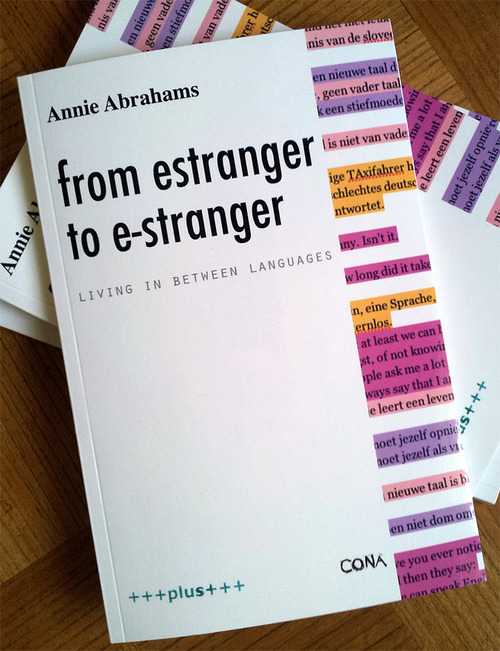
Abrahams’ book from estranger to e-stranger: Living in between languages is the analogue pendant to the blog, e-stranger.tumblr.com, that she began working on as a way to gather and present her research, thoughts, and documentation from performances and experiments during her residency at CONA in April 2014 and beyond. Her musings on, for instance, the effect dubbing films and tv programs from English into the local language, or simply screening the English original – how this seems to impact the population’s general fluency in English – raise significant questions about the globalisation of culture. And the internet is arguably even more influential than tv and cinema were/are because of the way it pervades every aspect of contemporary life.
This leads one irrevocably to consider the digital colonialism of today’s internet; the overwhelming dominance of western, northern, mainstream, urban, and mostly english-speaking people/systems/cultural and power structures. [1] Abrahams highlights the way that this bleeds into other areas of work, society, and cultural production, for example, through her citation of Mladen Stilinovic’s piece An Artist Who Cannot Speak English is No Artist (1994). In a recent blog post, Abrahams further reveals the systematic inequity of linguistic imperialism and (usually English speakers’) monolingualism, when she delves into the language politics of the EU and its diplomacy and parliament [http://e-stranger.tumblr.com/post/139842799561/europe-language-politics-policy].
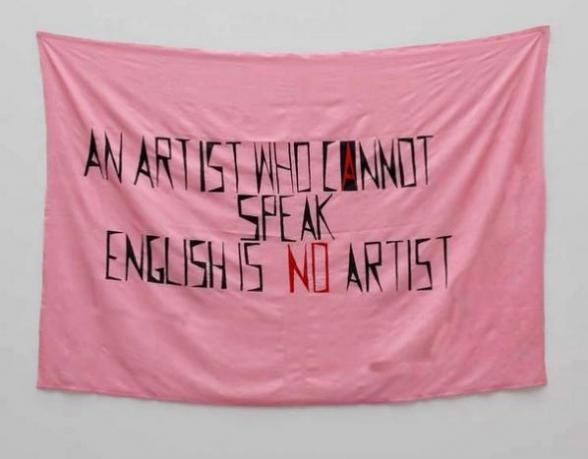
from estranger to e-stranger is an almost dadaist, associative, yet powerful interrogation of the accepted wisdoms, the supposed logic of language, and the power structures that it is routinely co-opted into enforcing. It is a consciously political act that Abrahams publishes her sometimes scattered text snippets – at turns associative or dissociative – in a wild mix of languages, still mostly English, but unfiltered, unedited, imperfect. A rebellion against the lengths to which non-native speakers are expected to go to disguise their linguistic idiosyncrasies (lest these imperfections be perceived as the result of imperfect thinking, logic, intelligence). And yet there is an ambivalence in Abrahams’ intimations about the internet that reflect the true complexity of this cultural and technological phenomena of digitalisation. Reading the book, one feels a keen criticism that is justifiably being levelled at the utopian web 2.0 rhetoric of democratisation, connection etc, but there are also moments of, perhaps, idealism, as when Abrahams asks “Is the internet my mother of tongues? a place where we are all nomads, where being a stranger to the other is the status quo.”
Abrahams’ project is timely, especially now that we are all (supposedly) living in an infinitely connected, post-cultural/post-national, online society, we are literally “living between languages”. The book is an excellent resource, because it is not a coherent, textual presentation of a thesis; of one way of thinking. It is, like the true face of the internet, a collection, a sample, of various thoughts, opinions, ideas, and examples from the past. One can read from estranger to e-stranger cover to cover, but even better is to dip in and out, and or to follow the links and different pages present, and be diverted to read another text that is mentioned, to return, to have an inspiration of one’s own and to follow that. But to keep coming back. There is more than enough food for thought here to sustain repeated readings.
Robert Jackson continues with a second journey into the realms of Accelerationism and Ordinaryism. Having articulated how Accelerationism merges Enlightenment principles in a supposed age of automation, Jackson interrogates its philosophical roots by suggesting that the core motivation behind its key approach embraces skepticism (even if the explicit method is to reject skepticism in favour of increasing applications of knowledge) – whereas what Ordinaryism suggests (following Cavell) is that skepticism cannot be refuted nor endorsed, only inhabited as a salient vulnerable conditon. The political implications of this division are telling and can be extrapolated through the freedom to Exit (inhuman acceleration) versus the freedom to find ones Voice (Ordinary appeal).
“But who is the authority when all are masters?” (Cavell, The Claim of Reason, p. 180).
For part 1 click HERE.
For part 3 click HERE.
In its philosophical usage ‘skepticism’ [i] hardly surfaces, if at all, in the contemporary Accelerationist lexicon. This is to be expected: as its political aspirations are organised by a cascade of philosophical trajectories designed to either refute skepticism, or as ordinaryism will claim, not bother to take it seriously enough.
Ordinaryism and Accelerationism approach familiar problems, even familiar desires, from familiar starting points, yet ultimately arrive at different conclusions. Most notably the political desire to overcome the intellectual chagrin of postmodern skepticism. Exactly what sort of overcoming is required feeds the conflict put forward: a conflict which has its history in the activity of reasoning as referenced earlier between Wilfrid Sellars and Stanley Cavell’s divulging and unique approaches to post-analytical knowledge.
Part 2 explores the following discord: Accelerationism (specifically its neo-rationalist, epistemic variant) builds a collection of political arguments which in order to work, have to refute skepticism. This is akin to (but not conflated with) the removal of skepticism in political emancipation through the practical competency of conceptual, normative reasoning. Ordinary, everyday experience is only considered as a human constraint that can be overcome or explained by a technological inhuman sovereignty of collective reasoning, where linguistic practice is essentially procedural, explanatory, functional and rule-governed. Alex Williams put it this way in his 2013 essay ‘Escape Velocities’;
Accelerationism in this guise is the project of maximizing rational capacity—the contents of knowledge about the world—and enabling the ramification of the conceptual space of reason… Enlightenment, rather than entailing an edifying reassurance of the humanistic order, instead gradually but irreparably modifies the manifest image of ourselves-in-the-world, stripping back the comforting homilies of humanism to reveal, Terminator-style, the gleaming bones of Sellars’s empty, formalist, rational subject lying beneath.
Ultimately Ordinaryism and Accelerationism want the same outcome though: the progressive aim for a better future in the face of the immediate everyday. But whereas Accelerationism thinks this can be achieved through the ascension of reason, Ordinaryism thinks it can be achieved only by acknowledging reason’s vulnerability. We must attend and attune to a diurnal world and others around us through the emotional exposure of claims rather than the Promethean expanse of the stars. Ordinaryism interrogates this force of Accelerationist reasoning and seeks a romantic alternative located in the epistemic, ethical and aesthetic priorities of responsiveness, alterity, otherness and appeal that are constitutive of the everyday and its fusion with technology. The larger attempt calls for the everyday to be reclaimed whilst surrounded by the purported effects of a ‘knowledge economy’. How is it that everytime we appeal for a new future, we are really appealing for a ‘new normal’?

The diagnosis establishes itself in the role of skepticism: and for Ordinaryists, skepticism cannot be refuted – only inhabited. Epistemic doubt has to be lived and coped with. The Cavellian lesson of the ordinary is that the world isn’t to be known, but to be acknowledged: a viewpoint which, presumably, would make the accelerationist hairs stand on end. But this not to say that ordinary acknowledgement – the everyday in general – is tantamount to political complicity and illusive habit. Ordinaryism only establishes an interest in what Cavell terms the eventual everyday, against the actual everyday of common sense, responding to the ordinary as if it appeared to us for the first time. Our relationship to others, and of the world, isn’t an exercise of philosophical skill which can be explained or solved because of an intellectual error, with its ambiguities swiped aside or viewed as insufficiently limiting. Nor is this condition indicative of ‘ordinary beliefs’ in public consensus whilst experts and technicians manipulate the structural groundwork behind the scenes: it is central to the democratic possibilities of all political activity. Bringing Cavell’s views of skepticism into focus allows us to acknowledge that politics is not well-serviced from a detached epistemological point of view: or an inhuman, impersonal space of reasons. One might wish to ask, why should any appeal to the strange tendencies of the inhuman take priority, when the familiar is equally as strange?
And following Cavell, the ‘ordinary’ in this view, is taken from the ordinary language philosopher’s commitment to reasoning. It appeals to “what we should say when..”: that any ordinary voice, what we ordinarily say, ordinarily mean, ordinarily know, has the same authority as any other when responding to what a situation calls for. Moreover, with ordinary language philosophy’s technique (in particular its leading practitioner J.L. Austin), one can simply take an instance of a word, used with certainty (I am free, I know) pick out all the ordinary, ambivalent uses philosophers don’t bother addressing, only to reveal as if for the first time, what it is we ordinarily accept everyday.
It’s a radical challenge that has a loose origin in Romanticism, but can be hinted at through punctuated periods of twentieth century philosophy. However the idiosyncratic musings of Wittgenstein interest us here, or at least those brought into fruition by Cavell’s masterpiece The Claim of Reason building towards later work on Emerson. Cavell remains indispensable here insofar as his collective, idiosyncratic view imparts a view of language, justification and reasoning based on the never-ensured acknowledgement of one other (and the claims of what we ordinarily say through one’s voice), in each specific and singular case of reasoning. This will be opposed against a neo-rational appeal to a universal inhuman force, waging on some quasi-guarantee that reason is alien, determinate and self-correcting.
In the space given I won’t be able to replicate the philosophy here at its most sophisticated, so we’ll have to settle for a more general level of enquiry that collates various, repeated aspects of the conflict involved. The remarks put forward will hopefully show why a Cavellian normative ‘Voice’ or ordinary appeal is an indispensable political tool, only because it treats skepticism seriously as an ordinary task in a world of increasing automation, not to superseded by a warped view of technology that can overcome it. Ordinaryism sheds a Cavellian insight that our relationship with technology fundamentally pivots on living our skepticism: inhabiting our condition, acknowledging our vulnerability, making ourselves intelligible to others, desiring an intimacy with things and establishing a voice to do so. The additional requirement here, comes to terms with the notion that skepticism isn’t a unique feature of ordinary language projected onto the world (as Cavell held), but is now operationalised in machinic systems. This is explicitly against an accelerationist insight, that machines operationalise the ascension of inhuman reason.
The problem is that Accelerationist reasoning simply refuses to consider skepticism as a problem, ridicules the everyday and instead pines for an inhuman, rule-bound determination of normative governance, which the ordinary cannot achieve. By doing so, it appears unconcerned with political dangers once the voice of others is rendered insufficient: that we could fail to acknowledge others, unwittingly presenting our relationships to knowledge and of other minds as unproblematic.
This unorthodox schism on reasoning can be exposed into a more contemporary technical conflict vying for political, philosophical and technological priority – call it, the freedom to Exit (inhuman acceleration) versus the freedom to find ones Voice (Ordinary appeal). The claim being that all political repercussions of Exit versus Voice pivot on whether you can refute skepticism, or inhabit its condition.
Over two years ago, Stanford University lecturer and entrepreneur Balaji S. Srinivasan delivered a speech at the 2013 Startup School event, entitled “Silicon Valley’s Ultimate Exit” (Transcript here). His talk was noteworthy for galvanising Silicon Valley cohorts into a usual online futurist catatonic stupor. But like all effective presentations Srinivasan delivered one simple, established idea into a contemporary setting and did so with honesty and gusto. Silicon Valley’s seemingly unstoppable knack for disrupting nearly all forms of cultural production and communication can be unpacked from an insight in 1970s political science.
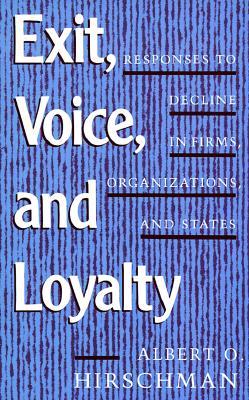
Srinivasan paid tribute to the landmark libertarian 1970 treatise “Exit, Voice, and Loyalty: Responses to Decline in Firms, Organi[s]ations, and States” by Albert O. Hirschman, in which the author stated the following economic conjecture: When any particular form of human system culturally designed to offer a service (a business, charity, government, country, state, school, etc.) experiences a decrease in quality, they have two options for freedom; either Exit or Voice. Put simply, Exit is the attempt to withdraw completely from the relationship provided with the aim of joining or starting up another, whereas Voice gives the customer the right to reform the existing relationship through protest and complaint.
Hirschman used these two options as a prism for opening up a range of economic and political outcomes that encapsulate ones freedom, equally emphasising that such models were mutually exclusive, operating in a parallel stop-start fashion. He understood Exit to be exclusively libertarian where freedom was guided under the economic freedom of the market, where decline could be corrected by ‘better’ services. Voice became the political freedom to confront existing decline by reforming the system within. Unpacked into differing global contexts, Exit vs. Voice shifts into multiple flavours of freedom, emanating from the same source. For a consumer, Exit manifests itself as the freedom to take your business elsewhere, whereas Voice is sending off a complaint form. For a country, Exit becomes emigration whereas Voice becomes the democratic right to vote. In the case of lobbying, Exit expresses itself as the think tank, whilst Voice emerges as the grassroots protest.
However Srinivasan took Hirschman’s options and gave the distinction a new technological edge relatable to an age of platforms, code, startups and disruption. Srinivasan suggested that Exit is a meta-concept which Silicon Valley has implicitly adopted, subsuming Voice without eliminating it (and perhaps even amplifying the latter). It is the hidden gear behind the Valley’s dominance, from various startup successes to the inherent properties of code itself. He cites the fact that Larry Page and Sergey Brin could never have reformed Microsoft from within, and so had to found Google by attaining the freedom to exit Microsoft completely, taking the sustained knowledge of their peers and independently crafting something smarter and better. Similarly, in software engineering if Voice operates as a patch designed to reform existing functional problems, Exit is the fork designed to splinter an existing platform of ineffective decline into a separate, and (presumably) more effective one.

But Srinivasan’s talk was essentially in support with ‘ultimate exit’ – the idea that the United States itself was completely beyond libertarian reform, and that Silicon Valley would in the next 10 years have to secede, and launch its own independent platform if it wanted to maintain freedom. Srinivasan’s rationale (which has solidified its popularity since 2013) is that if you can do it with a startup why not an entire country? It’s not exactly a pipe dream wither. A failed startup called Blueseed already sought funding in order to attempt such a feat, but it was eventually postponed. Blueseed was the closest attempt at creating an ultimate Exit, where a purposely built cruise liner, sailing twelve nautical miles from San Francisco, would allow entrepreneurs to create their own businesses without the need for a U.S work visa. Earlier still, a 2005 startup called SeaCode promised something similar, but similarly folded due to insufficient funding.
In the eyes of the Valley though, the Exit strategy has successfully challenged existing industries anyway; including Hollywood (through Netflix), print and television outlets (through social media), city transport (through Uber), currencies (through Bitcoin and Blockchain), healthcare (The Quantified Self movement), and even simple objects (3-D printing). Before the backlash hit the fan, Srinivasan’s foresaw that the only future worth betting on would involve building “an opt-in society, ultimately outside the United States, run by technology.” Who is John Galt? Presumably Balaji S. Srinivasan.
Randian fetishes aside Exit versus Voice is a clever forced choice. It’s designed to organise a schism in contemporary political thought where cultural activities and labour are increasingly wedded to automation: from casual acts of ordinary communication, to the darkest depths of hidden encryption. It’s a schism which the theoretical movement of Accelerationism is borne out from, despite the clear difference of its political goals and the varying flavours bundled with its name. Replacing Srinivasan’s libertarian freedom for a hard left emancipatory stance, Exit is now construed as engineering a post-capitalist exit, and ‘opting-out’ becomes inventing and repurposing technological infrastructure towards emancipation without losing any of the inhuman significance that got it there.
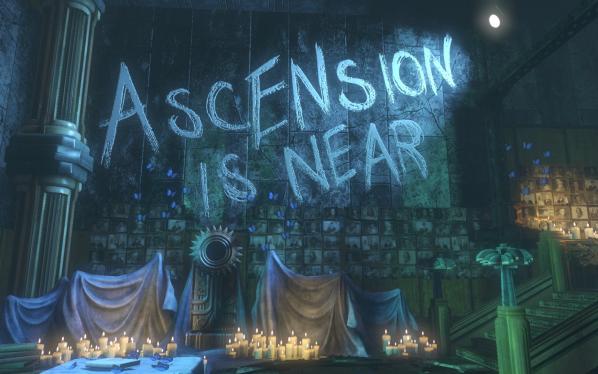
What is it however that philosophically separates the contemporary Left accelerationist position from previous iterations unable to grasp the future, or have resisted such attempts? We are of course reminded of such post-structural flights of fancy, (accelerationist musings of Lyotard, Deleuze and Guattari) to the experimental Cybernetic Cultural Research Unit (CCRU) whose famous figureheads included Nick Land & Sadie Plant. As many have already written, Land has become the quintessential prophet of the contemporary ‘Exit’ strategy (both in his early philosophical work, and later activities) understanding capitalism to be the ultimate engine of inhuman freedom. If our manifest fate is destined to head towards a technological singularity, it has only been put on ice because of meddling Marxists and (in his eyes) a dribbling progressive State. Having reorganised his views into neo-reactionism (NR-x), (which Srinivasan’s talk contributes to and in no small part, influentially gravitated a great number of libertarians towards), Land has one goal: the full realisation of ultimate exit. As Park MacDougald put it last year, Land’s;
Laissez-faire, in this view, is doomed to failure as soon as it’s up for a vote. Rather than accept creeping democratic socialism (which leads to “zombie apocalypse”), Land would prefer to simply abolish democracy and appoint a national CEO. This capitalist Leviathan would be, at a bare minimum, capable of rational long-term planning and aligning individual incentive structures with social well-being (CEO-as-Tiger-Mom). Individuals would have no say in government, but would be generally left alone, and free to leave. This right of “exit” is, for Land, the only meaningful right, and it’s opposed to democratic “voice,” where everyone gets a say, but is bound by the decisions of the majority — the fear being that the majority will decide to self-immolate.
Shockingly, Land’s NR-x demands the elimination of democratic voice altogether because, in his view, economically and socially effective governments legitimize themselves eschewing any appeal for a democratic voice. There isn’t any need for a voice if, like a commercial service, you can just exit your government and join a better one. So long as the functional technocratic inhuman is maximally realised there can be no room for moralism, sentimentality or suffering, for these are the very human traits which hold back our genuine freedom. Bending the market to fit human empathic needs will be futile. The sustained requirement for humans to lend a voice of political appeal is simply too ineffective to halt the inhuman onslaught of capitalist acceleration.
Cemented into the freedom to Exit is the implicit determination that all global technological progress (and its inherent possibilities as production) is bound up with the invisible, impersonal rigour of inhuman market competition, which democratic voice has little hope of addressing, let alone overthrowing. In Land’s view, capitalism is akin to an inhuman non-conceptual alien automatically programming human behaviour in order to drive it forward. This strange, foreign compulsiveness is integral to our dystopian future and Land’s job is to let the tap run (or more accurately, don’t pull the charger out).
So with Land’s current brand of libertarianism leaning more to the right than someone whose right leg has just been blown off, the political ground to develop a Left accelerationism has been given renewed impetus. As Peter Wolfendale previously pointed out, both positions jointly agree that capitalist production and modern developments of social justice are utterly incompatible, and the site of their incompatibility combined with technological expertise is what motivates both to conceive of an Exit: but crucially the discord between them comes from which set of principles should be exited from, and what sort of freedom is called for;
The right thinks that the accelerative emancipatory force is nothing other than capitalism itself, whereas the left thinks that capitalism is an adaptive and plastic obstacle suppressing a deeper emancipatory dynamic. It is in essence a disagreement about freedom: what it is to have it, what it is to enhance it, and whether there is anything we can do about it.
What both forms of freedom inhabit is to construct an exit from the limitations of the current status quo entrenched in reaction, resistance, refusal and reform. If the force of ‘Exit’ is what both movements share, then they also share the same schism of opposing Voice. And in one name or another, this is exactly what Nick Srnicek and Alex Williams have dubbed ‘folk politics’: political methods which eschew inhuman knowledge, global reach, feedback and technological infrastructure favouring instead outdated methods of reform, simplicity, horizontal plurality, immediacy and reactive protest (the 2008 Occupy protests being one example of many). In short, politics that might be associated with the demands of Voice. They may not wish to call it Voice, or be opposed to Voice democratically, and might even propose that it has some sort of place in contemporary political struggle. However, their opposition to a certain form of phenomenological immediacy in authentic resistance (which Voice might certaintly inhabit), carries all the connotations of leftist action they find strategically moribund. Reform and resistance are no longer the sole legitimate leftist options to overcome capitalism.
Their logic is two fold – 1.) reforming the capitalist system through protest, localism and critique alone has become useless at furthering leftist goals, often resulting in unashamed defeatism. Human acts of immediate protest and localism are no longer any match for the long term planning of inhuman complexity that global capitalism has become. The left simply sets itself up to fail.
2.) In light of this failure, contemporary leftist politics has a choice: either reduce political action to a relatable human local level, or embrace complex conceptual mediacy of capitalist process. In adopting the latter, the technological tools at our disposal afforded by capitalism must now invent alternative platforms repurposing leftist change, rather than chastised as oppressive, skeptical limits inherent to it. The left can no longer solely rely on ‘having a voice’ which appeals to habitual sit-ins and sporadic acts of resistance: it must invent alternative methods of infrastructure that will eventually abandon the need for capitalism, overcoming leftist resistance and reform completely (think André Gorz, but with Big Data and Apps).
The output of that challenge operates through various interlocking projects:
—Political theories for how a post-capitalist world that abolishes work can not only be made intelligible but be feasibly engineered (see Srnicek and Williams in their recently released publication ‘Inventing the Future: PostCapitalism and A World Without Work’ published by Verso). To be clear Srnicek and Williams entirely abandon the term ‘Accelerationism’, or ‘Left-accelerationism’ not specifically because of disagreement, but to alleviate widespread confusion.
—Renewed commitments to nineteenth/twentieth century cosmicism that manifests in a post-Earth future. Or alternatively treating science fiction as a necessary path towards a real exit (in its absolute form, exiting the Earth). (See Benedict Singleton’s Maximum Jailbreak)
—Regrounded developments in feminist strategies (see the recent xeno-feminist (XF) manifesto), by the anonymous collective Laboria Cuboniks which in their words asks that “Reason, like information, wants to be free, and patriarchy cannot give it freedom. Rationalism must itself be a feminism. XF marks the point where these claims intersect in a two-way dependency. It names reason as an engine of feminist emancipation, and declares the right of everyone to speak as no one in particular.”
—New strategies for art that oppose contemporary art’s global hegemony (See the forthcoming publication ‘On the necessity of Art’s Exit from Contemporary Art) by Suhail Malik. One might see a recent influence in Holly Herndon’s song “An Exit” which is describes Malik’s exit as “rather than act in angry opposition to an existing aesthetic or marketplace, we just walk away, facing towards the future”.

Yet, the lynchpin that passes through these varying outputs has one additional philosophical goal: one that has reshifted the political site upon which inhuman freedom can be realised through an interconnected philosophy beginning to rethink contemporary forms of reasoning, knowledge and rationalism.
What gives the Left accelerationists an injection of substance is not merely repeating Marxist demands that capitalism is an unjust, unequal system which promotes corpulent wealth, but that it primarily holds back the progressive and explanatory capacities of inhuman reasoning and technological progress (or at least that Voice, under this view, can only ever be the immediate starting point for an inhuman ascension).
Simply put, Left-accelerationism recognises both the lack of freedom and rationality and seeks to restore both in a more contemporary guise: the normative aim of constructing political freedom in ever greater inhuman measures. Thus the additional impulsion of Srnicek and Williams’ project stresses that the only method of overcoming capitalism is to self-master our epistemological knowledge of it , in order to apply methods that structure leverage towards rational self-determination. Here one almost tastes the accelerationist contempt for Leftist skepticism, and all of its appeals to doubt that have become complicit in contemporary forms of political action undermining progressive futurist thought. Skepticism for them, only bestows reason with a staggering lack of imagination and of lives that entirely accept the limits of neo-liberal stupor wrought by epistemic immediacy and affirmationist philosophies (distancing itself from the vitalist aspects of Deleuze and Guattari plays a key developmental role here).
The philosophical appeal toward a universal rationalist epistemology supports accelerationism’s desire to reengage with the Enlightenment project, where freedom becomes the binding of oneself to a universal rational rule (that must include and surpass capitalist and economic development) together with an adherence to that rule. More importantly the universalisation required must be a movement of Promethean ascension which promotes, as Williams puts it alongside Srnicek in an interview with Mohammed Salemy: “the idea that through our knowledge of the world and through political struggle, too, we can open new ways of being free that were unavailable to us before.” Inhuman Exit is rescued from the libertarian darkness of the NR-x hand, and into the clutches of unending rigorous collective reasoning. Inhuman freedom is repurposed away from compulsive slavery of alien market forces, to an alien rationality of a free rational subject that might exit from capital. The only alien demand is an inhuman demand to self-master our own possibilities towards rejecting capitalism (towards a post-capitalist future).
Williams has previously suggested that the twin thinkers of epistemic accelerationism are Ray Brassier and Reza Negarestani (whether these thinkers agree is another matter). Both are highly influenced by Land, and both are committed to an anti-skeptical method of gaining knowledge about the world, where the freedom to reason emerges as rule-governed, practical, revisable, autonomous and collective, not reducible to the manifest experience of humanity yet central to its emergence. Their neo-rationalism repeats the enlightenment’s desire to explain and act on the collective determinacy of the human epistemological condition outside any specific context.
The freedom to self-master an Exit lends its the support for a universal rationalist epistemology as enshrined within Sellars pragmatism (as outlined in Part 1 ). In this guise freedom becomes, according to Brassier, “… not simply the absence of external determination but the agent’s rational self-determination in and through its espousal of a universally applicable rule.” For complicated reasons Sellars sets out a pragmatist view of reasoning which is defined by its anti-skepticism as much as its Promethean promise (dependent on which thread of influence you follow). What makes such freedom a feature of pragmatism is that rationality is understood as an inherently social linguistic activity as well as a rule-based resource for expanding collective knowledge. Freedom through reasoning is grounded in essentially public and social normative practices of communication, that account for the correctness and incorrectness of ordinary linguistic usage and function. The accelerationist motivation is compelled by a pragmatist sensibility that rationality is founded by the capacity of a community to ‘agree in’ statements and judgements as normative commitments and entitlements. This domain from which freedom resides, and where it can be emancipated from, lies in a shared conceptual framework of utility.
The notion that human creatures are defined by living in a normative space of reasons has obvious overlapping concerns with the origins of philosophy, but only really found its teeth in the Enlightenment. The idea that I, as a rational subject can apply a certain concept means I must be committed to or bound by certain consequences. This can be traced through Plato and Aristotle, although the history takes its initial cue from Kant who understood human concepts to be uniquely and fundamentally normative, despite their finite status. Hegel then builds on Kant’s normative insight, eschewing the acknowledgement of finitude, by showing how freedom emerges from normative constraints inherent to discursive social statuses. Or putting it differently, developing an insight that the creation and generation of ideas and concepts arise in a shared normative medium. Freedom is thus, socially expressive, constitutive of norms and rules that already govern and constrain it, yet also subject to generative possibilities which it entertains. As Robert Pippin puts it;
… the problem of freedom, and in the Kantian/Hegelian tradition […] means being able somehow to own up to, justify, and stand behind one’s deeds (reclaim them as my own), and that involves (so it is argued) understanding what it is to be responsive to norms, reasons.(Pippin, The Persistence of Subjectivity: On the Kantian Aftermath, 2005, p. 11)
One of the most influential Hegelian ideas that the epistemic accelerationists have adopted (amongst others) is that without any justification, inferred assertion or claim – let alone a political claim – intelligible forms of progressive political action or agency are out of the question. No human communication occurs, principally, within the sole reducible product of a human individual, but as a distinctly social progressive achievement of reason and that ordinary modes of intelligibility have to be cemented in normative commitments of correctness. The job of philosophy is to offer an explanation constitutive of the very normative system it seeks to explain. Recoding these Kantian and Hegelian insights is said to establish and explain the inner workings of what we mean when we say something.
Clearly, the real reason why such Sellarsian normative accounts are useful is that they are characteristic of many philosophical attempts to comprehend language through a systematic and explainable structure, fully applying the force of reason with practices that commit effective conceptual action. It strips the rational subject back until it finds the primitive inhuman, artificial, functional, rational ‘machine’ guiding the system through the freedoms of feedback and function: What Sellars demarcates as the sapient, normative space of reasons (doing something for a reason) is understood to be completely separate from the sentient, causal nature of reasons (doing something because of a reason). Norms of reasoning cannot, like natural laws, suggest what will happen, but instead what ought to happen, and pinpoint shared, rational outcomes that can be correctly drawn from certain assumptions.
Responsibility and recognition cannot make sense outside of its social, discursive emergence, as is the case of any concept whatsoever, for concepts themselves are characteristically normative. Judgements that express knowledge are distinctively responsible and moreover they express themselves as social commitments. Normative claims and reasons are usually understood as not only bearing commitments and entitlements that take place in discursive behaviour, holding others as responsible, relating to an ideal, rule or standard: they are part and parcel of what it is to be a rational subject. Normative claims are taken to be reciprocal recognitions between human creatures who then take other assertions to be reciprocally rational and assertive to normative ideals, and thus expressive freedom is generated and determined. Thought and expression in this light, begins to give us a manifest grip on a non-perceptual world, which isn’t typically manifest (the dual roles of Sellars’ Manifest Image and Scientific Image provide this ‘grip’). The application of the concept, establishes what is correct as opposed to what might be taken to be phenomenally correct (and thus potentially wrong).
No wonder then this view appeals to general artificial intelligence as a futurist necessity, because sapience must be understood as different from the natural order. This is where Sellars’ anti-skepticism becomes obvious: not only reducing all human voice and communication to a primitive, determinate and rule-governed inhuman process which silently determines our linguistic activity, but at the same time, fully unleashing its ability to explain all possibilities of human communication, as well as what it means to freely communicate at all. It is distinctive that this peculiar inhuman force determines how we ought to act, only insofar as we can conceive it – seeing language this way is what demarcates the normative from the naturalistic, acting on norms is dependent on our recognition of them. Voice and speech simply becomes subordinate to this normative demarcation, because what we say is reducible to what can be thought.
This expressive toolkit for establishing a rational grip on non-perceptible systems in the world is necessary for epistemic-accelerationism. Like Land it commits to the idea that intelligence is wholly functional, but not tied to the machine of the free market, but the machine of rationality (which Land abhors). If it is the case that an inhuman grip of capitalism evades human representation, and with climate change becoming an ever greater non-human concern, then the entrenched political tactics of Voice, the task of the human, must embrace the promethean progress of science and technology and ascend our current cognitive resources accordingly. Srnicek thinks we can do this by returning to Fredric Jameson’s cognitive mapping – “the means to make our own world intelligible to ourselves through a situational understanding of our own position.” Other theorists express the same premise, but in different flavours: the field, the plot, the thread, the yarn. All yearn for the same process: the ongoing project to expand our cognitive intelligibility so that the left can master, identify, calculate and classify invisibly complex systems so as to change them for the better.
However, before we start (or try to start) building space programs and hedge funds for the Left there is a problem. Giving up on Voice becomes far too hasty, insofar as the accelerationist view of Voice is inherently predicated on function, it undermines the very intelligibility it desperately craves. There is a greater depth and vulnerability to Voice that must be addressed which stretches further than the quagmires of reform and resistance. If political intelligibility is predicated on problems of knowledge, questions surrounding what happens to political voice appear to be eradicated. So what happens to it? What might take on the form of addressing normative claims which speak on behalf of others? What might be the unintended political effects of “everyone speaking for no-one in particular”. How does this affect the silenced, who wish to make themselves known, rather than ‘being known’?
It’s easy for the epistemic accelerationists to address political authority if reason’s ascension can be established, but the harder questions arise if reason’s authority is primarily established by vulnerability.
[i] – I’m adopting the American spelling of skepticism here, in large part, because it’s easier to quote from Cavell texts for susequent sections.
Featured Image: Black Shoals: Dark Matter’, Joshua Portway, Lise Autogena, Big Bang Data.
Big Bang Data is a major travelling exhibition currently set within London’s Somerset House. That a large institution is presenting a journey via data capture through ‘selfies, surveillance and infographics’ is in itself an interesting patchwork of intent and realisation. The aim of the exhibition is to ‘demystify data’. This is a grand, summative and in actuality slightly awkward claim which, in my view, encapsulates the character of an interesting, textured exhibition in an unintentionally astute way.
As Big Bang Data is dedicated to revealing data comprehensively through its various architectures and iterations, it makes sense for the underrepresented materiality of information to have prominence early on. This materiality, perhaps inevitably, was compromised in the gallery space. Entering the first room brings you face to face with Timo Arnall’s Internet Machine, which takes the form of multiscreen video documentation of not just the machines, but also the architecture, which supports mobile telephony.

I would have loved to have experienced the spaces shown more intimately and walked around one of these structures; the installation was illuminating but I was still most certainly watching at a remove. This initial interplay of removal and involvement is central to the way we experience data. How can people begin to understand something which exists as multiple codes and flows, on a scale and at a speed which is not concerned with making itself understood by humans? What form could an understanding of data possibly take? When learning about something this far from our grasp, it seems that ‘understanding’ must be replaced by ‘awareness’. Rather than seeking one answer via one route the visitor to Big Bang Data has to build an impression, obviously subjective and subject to change.
In its quest to expose and explain data’s social and cultural uses, it presents a fairly overwhelming amount of information. It is interesting to walk through the space thinking about how this information has been channeled by each specific project. Some representations, such as Owen Mundy’s ‘I Know Where Your Cat Lives’, link distant people and spaces via connected points, while others such as Phillip Adrian’s ‘One Second’ capture in great detail one specific point in time and space.
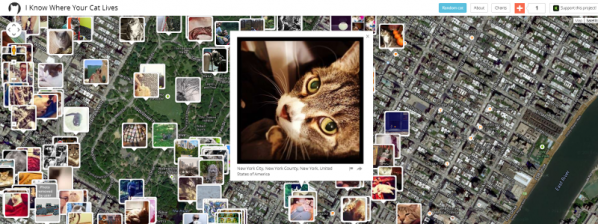
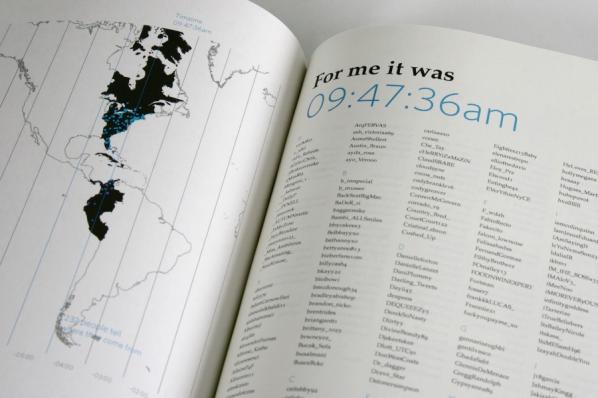
Julian Oliver’s ‘Transparency Grenade’ brings together graphical, console and physical representations of data to offer a transportable means of leaking information as a response to impenetrable governing systems. Each of the works on display demonstrates a negotiation between temporality, materiality and spatiality, and often one is sidelined in favour of the other. Again, considering the exhibition in this way is also to consider the world of data in all its contrariness.

Data manifests itself at the same time locally and globally. As well as addressing specificity, the projects shown in Big Bang Data dwell repeatedly on scale. Works such as Tejka’s ‘London Data Streams’ and Nicholas Felton’s ‘Annual Reports’ pit scales against each other to cast light on the filters through which data is processed.

Ingo Günther’s ‘World Processor’ and Forensic Architecture’s ‘Liquid Traces: The Left-To-Die Boat Case’ are examples of resonant, atypical data visualisations which mutate familiar imagery and present alternative summaries of events. The section entitled ‘Data For The Common Good’ shows some of the ways data is being actively used in society to empower citizens with works such as Safecast’s ‘bGeigie Nano’ and IF’s ‘Data Licenses’, while a series of video interviews with journalists and other professionals working with data illuminate the processes through which information becomes communication.

The previously mentioned tension between object and their presentation recurs at various points throughout the exhibition, a great example being the array of undersea telephone cables, presented in cases of wood and glass which could have been magpied from a display of historical artifacts (each cable segment has a number next to it which corresponds to a factual description). It felt strange not being able to touch them. A work which I felt fully occupied, and knowingly played with, its surroundings was Ellie Harrison’s vending machine, which sits unassumingly in the gift shop; its secret is that when search terms connected to the recession make the headlines, free snacks are dispensed. Its presence in a exhibition on data in a gallery space felt appropriate.

Big Bang Data, which runs alongside a programme of events and has previously been exhibited at CCCB in Barcelona, comes at a moment where large organisations are more frequently bringing concepts such as surveillance, open source and free software into public spaces. There is a great need to bring the concepts and processes surrounding data more wholly into the public eye, and this exhibition strikes me as, overall, a big step in a good direction. It makes real and challenging efforts to bring together world-spanning processes, complex concepts and extremely diverse content into an exhibition space. The task of the exhibition’s curatorial and production teams must have been difficult.
Of course the challenges they faced have been dealt with before many times in many ways, and of course the practical decision-making involved in producing an exhibition invariably creates tension points. The reason I’ve dwelt on the problems of the organisers here is that the tensions evidenced within the space at Somerset House say much not just about the response of the publicly funded arts to data but also about the nature of data itself. The exhibition turns into at times a museum, a bedroom, a classroom, an information point, a scruffy new gallery space and a state of the art new media space. In bringing together the story of data the exhibition also brings together the story of representation in space more generally.
In writing about Big Bang Data I have had to choose to highlight certain works and not others. Your interpretation will be entirely different from mine, which is as it should be where data and cultural inclusion is concerned. What’s important is that the exhibition’s prominence and texture opens up conversation and critique. The exhibition is detailed, procedural and expansive. It is also alive with contrariness, generality and awkwardness. Perhaps one of the great things about the show is that these qualities are left to jostle for space. For me, reading this exhibition as a performative event was useful; others may leave Somerset House with an entirely different view having taken an entirely different route. This is inevitable where data is concerned – learning is incremental and procedural, but not traditionally linear.
French artists Émilie Brout and Maxime Marion contribute three pieces to The Human Face of Cryptoeconomies exhibition. Gold and Glitter is a painstakingly assembled installation of collaged GIFs. Previous installations have featured the GIFs displayed on a gold iPad atop a pile of collected gold trinkets; at Furtherfield Gallery now a single golden helium balloon hovers in front of a floor to ceiling projection. Nakamoto (The Proof) is video documentation of the artists’ efforts to try and place a face on the elusive Bitcoin creator, Satoshi Nakamoto (but is it his face in the end? We don’t know). Untitled SAS is a registered French company without employees and whose sole purpose is to exist as a work of art.
Brout and Marion’s work can be situated among artists and art practices who have grappled with how to think about value and objects—or more precisely, how objects are inscribed (and sometimes not) into an idea of what is valuable. In a recent article for Mute Magazine, authors Daniel Spaulding and Nicole Demby point out that “Value is a specific social relation that causes the products of labor to appear and to exchange as equivalents; it is not an all-penetrating miasma.”1 Value is a process by which bodies are sorted and edited but it is not a default spectrum on to which all bodies must fall in varying degrees. This clarification makes explicit the fact that while the relationships productive of value allow “products of labor to appear and to [be exchanged]”2 this is not an effect that is extended to all products of labor. Attempts to isolate the underlying logic of this sorting mechanism are often at the heart of art practices dealing with questions of value and commodification. Like Andy Warhol’s Brillo Boxes or Marcel Duchamp’s Fountain, these artworks become interesting problematics for the question of art and value for the ways in which they are able to straddle two economic realms—that of the art object and the commercial object—while resisting total inclusion in either.
The Human Face of Cryptoeconomies picks up these themes in an art context and repositions them alongside digital cultures and emerging digital economies. In Brout and Marion’s work alone, concepts of kitsch, identity, and human capital have been inhabited and imported from their originary realms into the digital. Answering questions remotely, Brout and Marion were kind enough to give us some insights into their work and process. My goal here has been to draw out some points about the operation of value that are at work in Brout and Marion’s practice, as well as to point towards an idea of how value is transformed, or even mutated, in the digital age.
* * *

Brout and Marion open up with an interesting provocation. They explain, “When we showed the project [Glitter and Gold] in Paris this year, people stole a lot of objects, even if they were very cheap. Gold has an incredible power of attraction.”
It is telling, to some extent, that Brout and Marion’s meditations on gold have an almost direct link to the visual metaphor used by Clement Greenberg in his 1939 essay Avante-Garde and Kitsch to describe the relation between culture—epitomized in the avant-garde—and the ruling class. Greenberg writes, “No culture can develop without a social basis, without a source of stable income. And in the case of the avant-garde, this was provided by an elite among the ruling class of that society from which it assumed itself to be cut off, but to which it has always remained attached by an umbilical cord of gold.”3 This relation is subverted in Gold and Glitter, which takes for its currency—its umbilical cord of gold—a kind of unquantifiable labor that is seemingly (and perhaps somewhat sinisterly) always embedded in discussions of the digital.
For Greenberg, kitsch always existed in relation to the avant-garde; one fed and supported the other, even if the way in which that relation of sustenance worked was by negation. And while Greenberg’s theory relies on his own strict allegiances to hierarchical society, privileged classes, the values of private property, and all the other divisive tenets of capitalism that we now know all too well can be destructive. Kitsch remains useful to us for the ways in which it allows the means of production to enter into a consideration of aesthetics. Here the recent writing of Boris Groys can be useful. In an essay written for e-flux titled Art and Money, Groys makes a compelling case for why we should persist in a sympathetic reading of Greenberg. He argues that Greenberg’s incisions amongst the haves and have nots of culture can be cut across different lines; that because Greenberg identifies avant-garde art as art that is invested in demonstrating the way in which is it is made and it doesn’t allow for its evaluation by taste. Avant-garde art shows its guts to us all, and on equal terms—“its productive side, its poetics, the devices and practices that bring it into being” and inasmuch “should be analyzed according the same criteria as objects like cars, trains, or planes.”4
For Groys this distinction situates the avant-garde within a constructivist and productivist context, opening up artworks themselves to be appreciated for their production, or rather, “in terms that refer more to the activities of scientists and workers than to the lifestyle of the leisure class.”5 In this way Glitter and Gold, like Brout and Marion’s other artworks, is to be appreciated not for any transcendent reason but rather for the means by which it came into existence. ‘The processes of searching and collaging golden GIFs sit side by side with the physical work of accumulating the golden trinkets for display: “We collected these objects for a long time” the artists explain, “some were personal objects (child dolphin pendant, in true gold), others were given or found in flea markets, bought in bazaars … We wanted to have a lot of different types and symbols, from a Hand of Fatima to golden chain, skulls, butterflies, etc.”

Furthermore, Glitter and Gold can be understood as the product of compounding labors: the labor of Brout and Marion in collecting their artifacts, the labor necessary to create the artifacts, the labor of GIF artists, the labor of searching for said GIFs, the labor of weaving a digital collage. These on-going processes forge, trace, and re-trace paths during which, at some point, gold takes on the function as aesthetic shorthand for value. As Brout and Marion explain, “Here the question is more about the intrinsic values we all find in Gold, even when it just looks like gold. Gold turns any prosaic product into something desirable. [Gold and Glitter] is less about economics than about perceived value.”
Groys provides his reading of Greenberg as a means of pointing towards a materiality that is always in excess of existing coordinates of value. If value always reveals the products of labor as they enter into a zone of exchange, it is something else proper to contemporary art that reveals another materiality beyond this exchange. For Groys, this something else is at work in the dynamics of art exhibition, which can render visible otherwise invisible forces and their material substrates. This is certainly a potential that is explored by Brout and Marion. In Nakamoto (The Proof), the viewer can watch the artists’ attempt at creating a passport for the infamous and elusive Bitcoin creator Satoshi Nakamoto. At present, it is unclear whether Nakamoto is a single person or group of people, though the Nakamoto legacy as creator of Bitcoin, a virtual currency widely used on darknets, is larger than life. Adding to this myth, after publishing the paper to kickstart bitcoin via the Cryptography Mailing List in 2008, and launching the Bitcoin software client in 2009, Nakamoto has only sporadically been seen participating in the project with others via mailing lists before making a final, formal disappearance in 2011, explaining that he/she/they had “moved on to other things.”6 Nakamoto’s disappearance, coupled with the fact that Nakamoto’s estimated net worth must be somewhere in the hundred millions Euros, has given rise to the modern-day myth of Nakamoto, and with it an insatiable curiosity to uncover the identity and whereabouts of the elusive Bitcoin creator.
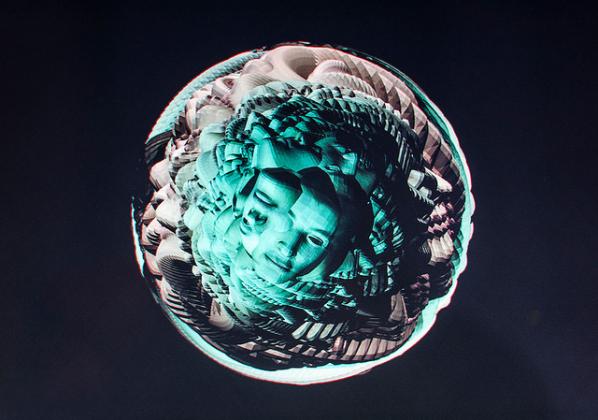
Brout and Marion make their own attempt to summons the mysterious Nakamoto back to life by putting together the evidence of Nakamoto’s existence and procuring a Japanese passport using none other than the technologies that Nakamoto’s Bitcoin both imparted and facilitated. When asked if they feared for their own self-preservation in seeing this project through, Brout and Marion answered, “Yes, even if we were pretty sure that it would be easy to prove our intention to the authorities, and that the fake passport couldn’t be useful to anybody, buying a fake passport is still illegal.” They add, “But we also wanted to play the game entirely, so we made every possible effort to preserve our anonymity during our journey on the darknets.”
However Brout and Marion have yet to receive the passport; as they explain, “The last time we received information, the document was in transit at the Romanian border.” When asked if they expect to receive the passport, they respond, “No, today we think we will never receive it. We are completely sure that it has existed, but we’ll surely never know what happened to it.” What, then, will they do if they never receive the passport? “Maybe just continue to exhibit the only proof of it we have!” they exclaim. “There is something beautiful in it: we tried to create a physical proof of the existence of a contemporary myth, using digital technology and digital money, and the only thing we have is a scan!”
If Brout and Marion’s nonchalance seems unexpected then it is because the disappearance of the passport for the artists marks just another ebb in the overall flow of their piece; a flow that began with Nakamoto, coursed through their clandestine chats via a Tor networked browser and high security email, and now continues to trickle on while we wait in anticipation for the next chapter of the Nakamoto passport to reveal itself. In this respect, the anticipation of the passport is a poetic and unforeseen layer added to the significance of the piece: “Maybe it is even better [that the passport should not arrive]” Brout and Marion comment. “It’s like it was impossible to bring Nakamoto out of the digital world.”

If value is always formed by way of a social relation, then how do digital modes of sociality also deliver this effect? This becomes a particularly fraught question when considering that, as Anna Munster has written, the sociality that takes place on the internet can be understood as the interrelation of any number of subjectivities, both organic and inorganic. Brout and Marion’s ambivalence to the purloined passport highlights just such an expectation: “Here the lack of identity delivers a lot of value. Look at Snowden: journalists ask him more about his girlfriend than about his revelations. Making something as big as Bitcoin and staying perfectly anonymous? These are strong attacks to two of the most important issues of our societies: banks and privacy.” What their statement suggests is how a collective movement towards transgression, here seen as compounding maneuvers of avoidance of physical world boundaries and institutions, might hold within it the promise of its own set of value coordinates. As Brout and Marion further explain: “For us, Nakamoto is absolutely fascinating. The efforts he made to prevent himself from being turned into a product are incredible. Especially when you know the importance of [Bitcoin’s] creation, and that only a few men in the world are smart enough to create something like this. Adding to that the fact that Nakamoto is probably a millionaire, you have one of the only true contemporary myths, something hard to find credible even if it was just a fictional character in a movie. So this somewhat absurd attempt to create a proof of Nakamoto’s existence was, for us, an attempt to make a portrait of him, to put light on his figure. And, in some ways, a tribute.”
Brout and Marion mount a final probe into questions of value in their piece, Untitled SAS. Untitled SAS is the name for Brout and Marion’s corporation whose purpose and medium is to exist as a work of art. In France SAS means société par actions simplifée, and is the Anglophone equivalent of an LTD. SAS companies have shares that can be freely traded between shareholders. Untitled SAS, in Brout and Marion’s own words, “has no other purpose than to be a work of art: it won’t buy or sell anything, there won’t be employees, its existence is an end it itself. The share capital of the company is 1 Euro (the minimum), and we edited 10,000 shares owned by us (5,000 for each one). Everybody can freely buy and sell shares of this company.” Brout and Marion are clear: in no uncertain terms, “Untitled SAS is a work of art where the medium is a real company, and the corporate purpose of this company is simply to be a work of art.”

Untitled SAS is a tongue in cheek commentary on the situating of artworks as outside of the rational space of the market while still being subject to selective norms of economic behavior. Brout and Marion explain, “Untitled SASis obviously a metaphor for the art market, and the market in general: it is a true, fully legal, and functional speculation bubble. Companies usually try to create some concrete value, they are means. The art world has fewer rules than the regular market, the price of some artworks can radically change in few days without any logical reason: their intrinsic value is completely uncorrelated to their market value. We wanted to reproduce and play with these systems in the scale of an artwork.” At this level, what Brout and Marion uncover is further proof of the condition of the contemporary art period as Groys sees it: a time in which “mass artistic production [follows] an era of mass art consumption” and by extension “means that today’s artist lives and works primarily among art producers—not among art consumers.”7
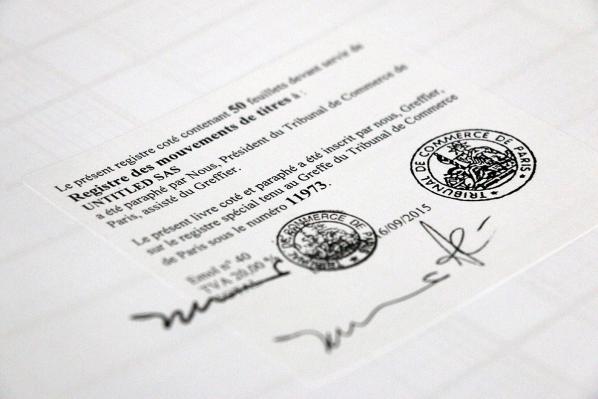
Crucially, the effect of this condition is that contemporary professional artists “investigate and manifest mass art production, not elitist or mass art consumption.” This is the mode of art making precisely employed by Brout and Marion in the creation of Untitled SAS. It has the added effect, too, of creating an artwork that can exist outside the problem of taste and aesthetic attitude. Companies tend to eschew taste qualifications in favor of brand associations. Untitled SAS becomes readable as an artwork, as Untitled SAS, when the expectations and regulations of a nationally recognized business are made to butt up against the inconsistencies of the artworld as an economic sphere. The art object then becomes rather a means of accessing the overlapping paths of art and value as they are uniquely enabled to circulate in and out of the art & Capitalist markets.
* * *
Brout and Marion note that, “In our work we often use algorithms and generative ways to produce things, but here we wanted to something no machine can do, something hand-made, too, finally a simple and traditional work of art.” These kinds of generative technological processes and sorting algorithms have been central to many debates on how contemporary culture is absorbing the boon of big data: from ethical questions on predictive policing to dating apps and ride-hailing startups. As one Slate article posed the question in relation to Uber, these algorithms are more than just quick and efficient modes of labor—they are reflections of the marketplace themselves.
So what, then, might it mean that both values and services in the digital age are predicated on the power to sort and categorize, and that this power is ciphered through its own dynamic of social relations, but that in one scenario what emerges is a sphere of the valuable and in the other a software that asserts itself as benign and at the behest of an impartial, impersonal data? Perhaps the rationality of value and market circulation vis a vis the art object was always going to be a little too tricky to take on: too many exceptions, too many questions of subjectivity, taste, and judgment. But as the works exhibited for The Human Face of Cryptoeconomies might suggest the rationality of value and the products it chooses to incorporate is of high importance. If value works precisely because of the specific interrelating of social subjects then we can consider the realm of the digital as a concentrated form of such a relation.
Against this we must consider the new subject that is produced and addressed by the intersecting of these discussions. Spaulding and Demby make the case that, that “Art under capitalism is a good model of the freedom that posits the subject as an abstract bundle of legal rights assuring formal equality while ignoring a material reality determined by other forms of systematic inequality.”8 Karen Gregory, in The Datalogical Turn, writes, “In the case of personal data, it is not the details of that data or a single digital trail that are important, it is rather the relationship of the emergent attitudes of digital trails en mass that allow for both the broadly sweeping and the particularised modes of affective measure and control. Big data doesn’t care about ‘you’ so much as the bits of seemingly random information that bodies generate or that they leave as a data trail”.
The works of Brout and Marion exhibited at the Human Face of Crypotoeconomies exhibition places the intimacy of the body front and center. They speak to the shadow and trace of the body by appropriating the paths of the faceless, or by giving a face to the man (or entity) without a body, to becoming the human face of the market player par excellence by inserting themselves into a solipsistic art corporation. Brout and Marion’s practice understands that while value may not be an all-penetrating miasma, this is not also to say that the effect of value is not still inscribed on the flesh of each and all, organic or not.
1 Demby, “Art, Value, and the Freedom Fetish | Mute.”
2 Ibid.
3 Greenberg, “Avant-Garde and Kitsch,” 543.
4 Ibid.
5 Ibid.
6 “Who Is Satoshi Nakamoto?”
7 Groys, “Art and Money.”
8 Ibid.
Stanza is an internationally recognised artist who has been exhibiting worldwide since 1984. He has won so many prizes you’d have trouble fitting them all on one mantlepiece. He has exhibited over fifty exhibitions globally and is an expert in arts technology, CCTV, online networks, touch screens, environmental sensors, and interaction. His artworks examine artistic and technical perspectives, within the contexts of architecture, data spaces and online environments.
Recurring themes throughout his career include the urban landscape, surveillance culture, privacy and alienation in the city. Stanza is interested in the patterns we leave behind, and real time networked events, that are usually re-imagined and sourced for information. He uses multiple new technologies so to create distances between real time, multi point perspectives that emphasis a new visual space. The purpose of this is to communicate feelings and emotions that we encounter daily which impact on our lives and which are outside our control.
Much of his work has centered on the idea of the city as a display system and various projects have been made using live data, the use of live data in architectural space, and how it can be made into meaningful representations. See Publicity, Robotica, Sensity, as well as a whole series of work manipulating real time CCTV data to making artworks with them: See, Velocity, Authenticity, Urban Generation. These works reform the data, work with the idea of bringing data from outside into the inside, and then present it back out again in open ended systems where the public is often engaged in or directly embedded in the artwork. Interactive and visually appealing, his style also maintains the substantive power through multi-facetted content.
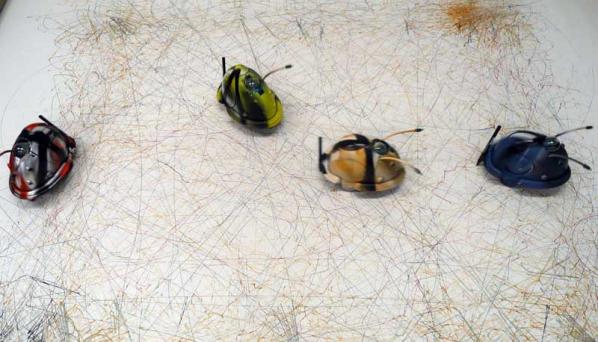
Marc Garrett: Could you tell us who has inspired you the most in your work and why?
Stanza: I don’t really get inspiration from the “who” question, I prefer the “what” and “why” questions. As a professional artist I look at loads of art so to understand what art is and can be, and it’s always an ever changing and fluid response. I also spend a lot of time ignoring stuff and material; (focused ignoring) because it has become harder and harder to see though the fog; the noise of it all. Maybe it’s better to think of a working model for inspiration, Andy Warhol had one. Just make the work. That’s what I do. I am not a part time artist in academia or an artist with another job, I’ve done this for the last thirty years, inspired by and in response to the world around me.
This dogmatic commitment to my work comes from my believes that the system you have to trust and invest in yourself. Inspiration, quite literally is everything all around you all at once, all at the same time, moment by moment. This is what inspires my work and it influences the creation of real time information flows, and works in parallel realities. It allows me to stand back at a distance and work with complex data sets while at the same time making meaning from them. Forming data into a shape, because this confluence might inspire a repositioning of thought and values while at the same time unlocking a hidden meaning to enable the viewer to feel and experience something new or to do something creative with the results.
MG: How have they influenced your own practice and could you share with us some examples?
S: There’s a saying be careful what you wish for. If one reverses this then it could be wish for what you want and need. Influence is problematic because it’s both negative and positive. The idea of influence seems causal, but my own practise isn’t based on influence but in research into certain themes. This enables me to get into both sides of particular questions or debate, so to frame the work I make. Works like these have been inspired by this focus…
The Singing Trees, focus in the invisible things and the environment http://stanza.co.uk/tree/index.html
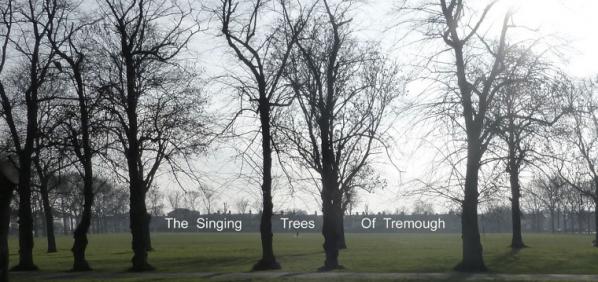
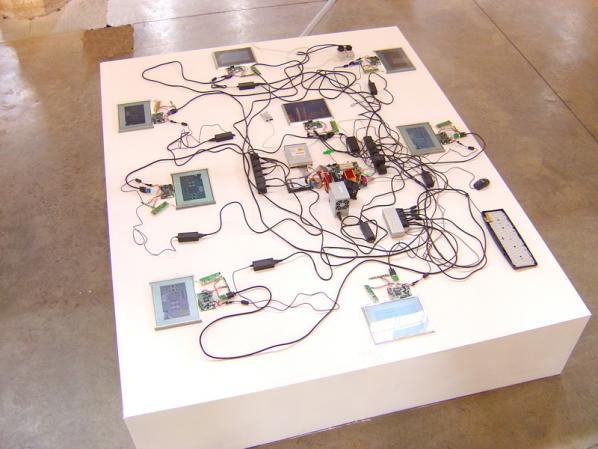
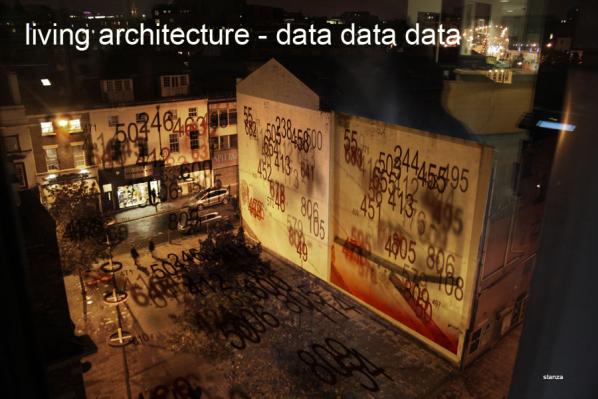
MG: How different is your work from your influences and what are the reasons for this?
S: I have been researching smart cites, urbanisn, and have collected ‘big data’ since 2004. I have been building my own wireless sensor network. This eventually manifested itself in an artwork called Capacities in 2010 which then influenced all the others in the series until it now has this form.
Capacities: Life In The Emergent City, captures the changes over time in the environment (city) and represents the changing life and complexity of space as an emergent artwork
http://stanza.co.uk/capacities/index.html


Which led to…
The Nemesis Machine- From Metropolis to Megalopolis to Ecumenopolis.
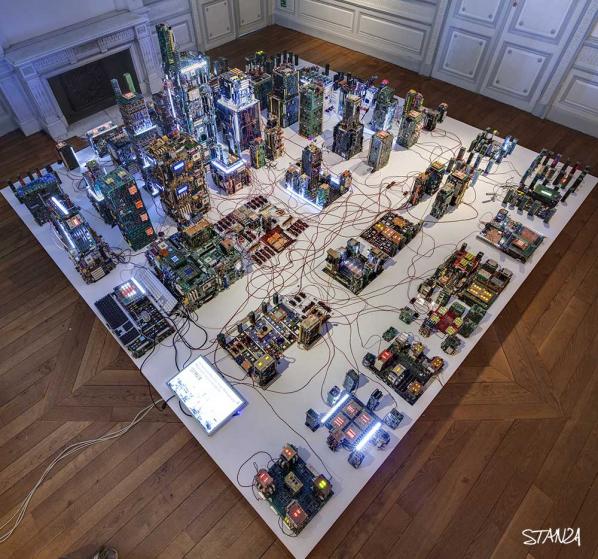
“A Mini, Mechanical Metropolis Runs On Real-Time Urban Data. The artwork captures the changes over time in the environment (city) and represents the changing life and complexity of space as an emergent artwork. The artwork explores new ways of thinking about life, emergence and interaction within public space. The project uses environmental monitoring technologies and security based technologies, to question audiences’ experiences of real time events and create visualizations of life as it unfolds. The installation goes beyond simple single user interaction to monitor and survey in real time the whole city and entirely represent the complexities of the real time city as a shifting morphing complex system.
The data and their interactions – that is, the events occurring in the environment that surrounds and envelops the installation – are translated into the force that brings the electronic city to life by causing movement and change – that is, new events and actions – to occur. In this way the city performs itself in real time through its physical avatar or electronic double: The city performs itself through an-other city. Cause and effect become apparent in a discreet, intuitive manner, when certain events that occur in the real city cause certain other events to occur in its completely different, but seamlessly incorporated, double. The avatar city is not only controlled by the real city in terms of its function and operation, but also utterly dependent upon it for its existence.”
MG: Is there something you’d like to change in the art world, or in fields of art, technology and social change; if so, what would it be?
S: It’s the museum I would like to change or engage with. It seems that anything and everything will end up in the museum. We have become the museum. We are the sum of our collections catalogs and archives. Since the current trend is for public engagement we will see a mix of these new technologies aiding and abetting this and various dialogues.
Therefore these questions need to be raised more vocally. How do visitors interact with each other and artworks? How do visitors behave in public space and what patterns or communities do they form. Can these outputs reshape our experience of public space and the art?
So, new immersive technologies could be used to investigate how visitors interact with art works, with each other and what impact their experiences have in forming new user interactions within public space. This space could be made more social and lead to new real time artworks based on visitor interaction and new visualizations of the gallery space based on gathered data.
Artists used to occupy specific issues but now there aren’t many topics artists haven’t engaged in or reached out to. The issues that will resonate will be the ones closest to the issue of the day…. and, they will be economics, the environment and migration. Because of this I would like to less focus on public engagement spectacle or entertainment and more on the quality and public engagement rooted in intellectual rigour.
Technology affords new ways of working with audiences and curators as participants in artworks. The concept of the exhibition as an active site for experimentation and collaboration between curators, artists and audiences prefigures a general cultural movement towards the centrality of experience and away from the reification of the object.
However, how audience activities and movements can be used as the subject of new artwork as well as modify engagement with existing collections is a cultural and technological challenge.
SeePublic Domain: You Are My Property, My Data, My Art, My Love.

The Public Domain Series involves using live CCTV systems that are already installed then using these cameras to enhance gallery space and the audiences experience of the gallery. http://stanza.co.uk/public_domain_outside/index.html
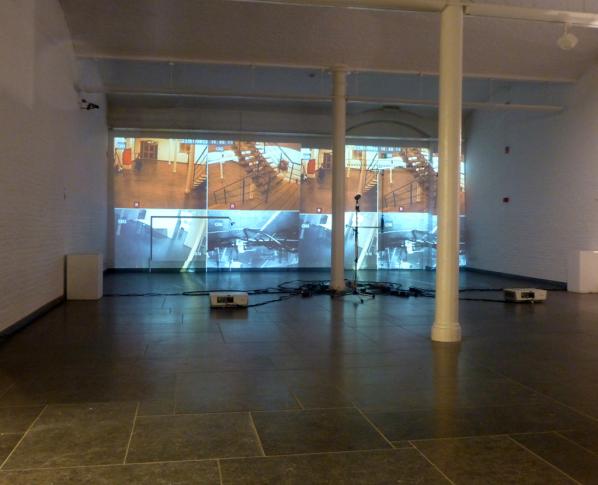
Visitors to a Gallery – referential self, embedded. Stanza uses a live CCTV system inside an art gallery to create a responsive mediated architecture. Anyone in any of the galleries and all spaces in the building can appear inside the artwork at any time.
http://stanza.co.uk/cctv_web/index.html
The social challenge within urban space is one I like to play with. In The Binary Graffiti Club, is a project I set up to try and work in this area. The Binary Graffiti Club are invited members of the public at each location for each event; they are given the hoodie to keep as thanks for their participation and contribution. The Binary Graffiti Club set off across the city and create artworks.
http://stanza.co.uk/binary_club/index.html
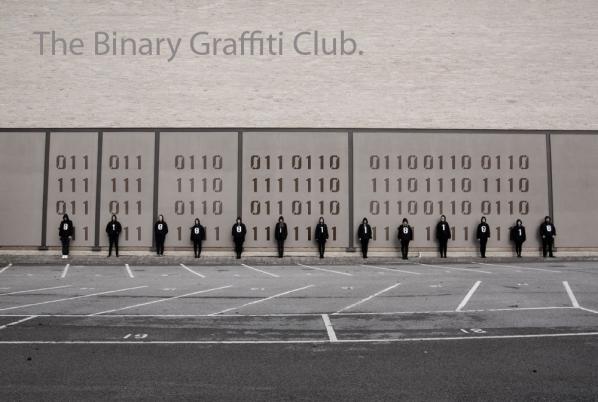
“Youths dressed in black hoodies swarmed the historic city streets of Lincoln during Frequency Festival 2013, their backs emblazoned with bold white digits, the zeros and ones. Their ominous presence was marked with a series of binary code graff-tags on official buildings throughout the city; messages of insurrection for a digital cult now active among us or analogue reminders of the digital soup of signals we wade through on a daily basis? There’s an engaging playfulness and an aesthetic pleasure to Stanza’s work that pays rewards on deeper investigation. His urban interventions remind us of the invisible occupation of the cyberspace around us and encourages us to ask whose hand manipulates these systems of control.” Barry Hale, Festival Co-Director of Frequency Festival 2013: Stanza: Timescapes/Binary Graffiti Club.
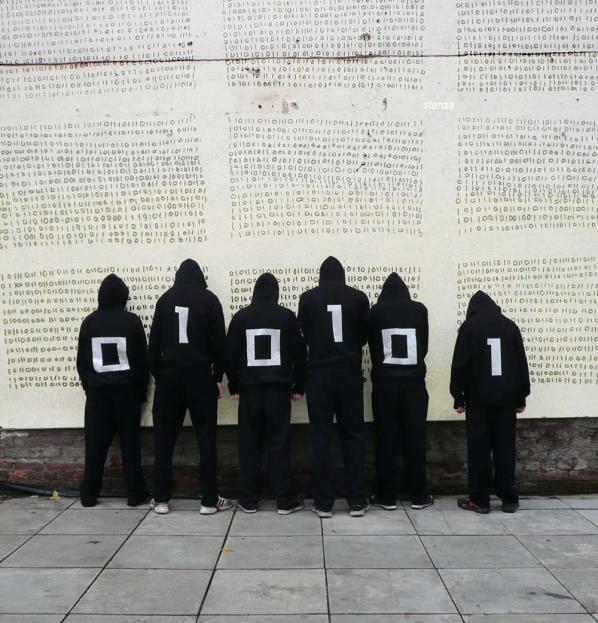
MG: Describe a real-life situation that inspired you and then describe a current idea or art work that has inspired you?
The invention of the toothpaste tube caused a revolution in painting.
The greatest discovery of the age was that the world is full of atoms.
Doing many small things instead one on big thing.
We seam to victimise out children we give them ASBO’S and anti social behaviour orders. For a while I wanted one. They actually give you a certificate like rockers, mods punks etc. The hoodie is a symbol of youth culture as well as being anti social. My new artwork the Reader and the idea of reading books and being anti-social led to this project.
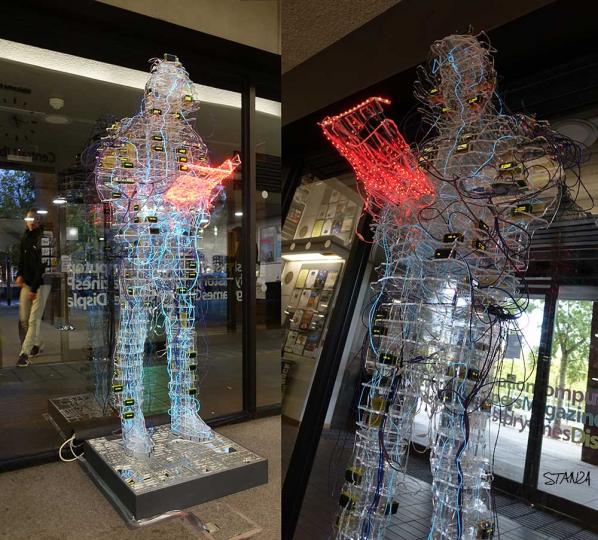
The Reader is a large six foot sculpture of the artist Stanza wearing a hoodie reading a book. The artwork is a metaphor for the engagement of reading in the digital age. The sculpture acts as a focal point for community and public engagement and has taken over one year to make and design; it has been commissioned to act as a focal point for the identity of the library. The reader reads all the books published since 1953 inside a data body sculpture. http://stanza.co.uk/TheReader_web/
MG: What’s the best piece of advice you can give to anyone thinking of starting up in the fields of art, technology and or social change?
S: Make work, make more work, and remember nothing lasts forever except true love.
Re: Art, Study it
Re: Technology. Learn it
Re: Social change . Be part of it.
MG: Finally, could you recommend any reading materials or exhibitions past or present that you think would be great for the readers to view, and if so why?
Yes the Books…
The Bible The Quran And The Torah.
Because…they are the most influential books ever written and have guided the lives of billions so it’s a good idea to have had a read… at least “view” them.
See…
Lost in Translation. This custom made robot responds to a series of texts and makes drawings unique to each reader. The work questions not only the meaning and interpretation of text but just who controls our understanding of the outputs and indeed what is Lost In Translation. This is a very playful user friendly work and actively engages the audience not only to think about the text but the meaning of how automation and networked technology is changing the control of understanding. http://stanza.co.uk/lost_in_translation/
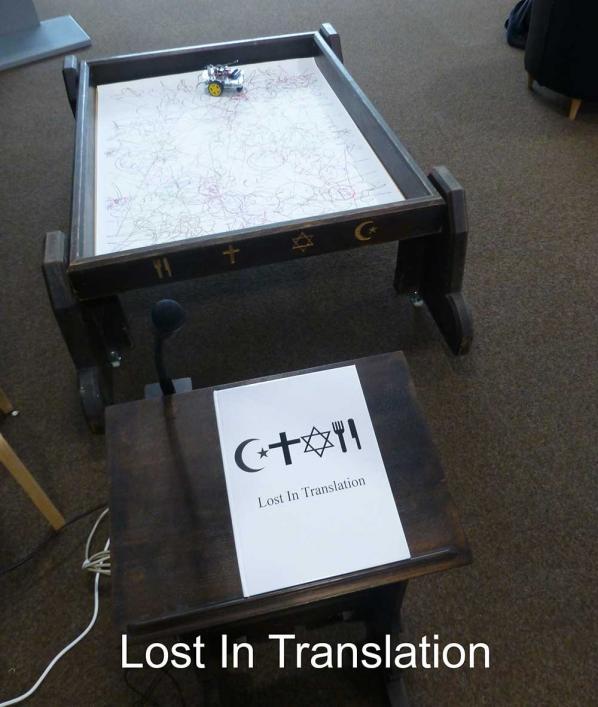
Thank you…
The negotiation of the commons takes place in two distinct realms that are increasingly reaching into and shaping one another: the long history of the landscape commons both in cities and in the countryside, and across digital networks. In both realms we find the continued project of the enclosures, appropriating forms of collectively-created use value and converting it, wherever possible, into exchange value. In this conversation Ruth Catlow and Tim Waterman discuss the ‘Reading the Commons’ project together with Furtherfield’s work on understanding the commons.
Ruth Catlow is an artist and co-founder co-director of Furtherfield. Tim Waterman is a landscape architectural and urban theorist and critic at the University of Greenwich and Research Associate for Landscape and Commons at Furtherfield.
*
TW: I’ll start with a little background. ‘Reading the Commons’ is an ongoing project which we initiated that seeks to find a place of power in order to defend the continual project of the creation of the commons in all realms in the future and to augment and magnify other similar endeavours by other groups and organisations. We knew that there is already a lot of work being done in and around the idea of the commons, so we were less interested in staking out any intellectual ground than we were in making connections and finding ways of sharing research and experiences amongst ourselves and other interested parties. So far two groups have been assembled to read and discuss. The first was convened in the summer of 2014 at Furtherfield Commons, the community lab space in the South West corner of Finsbury Park, and was composed of a broad range of academics and practitioners from different disciplines.[1] It met once a fortnight for several months and discussion was wide-ranging. The second was in the Summer of 2015 and involved a group of Master’s students in curation at Goldsmiths under the direction of Ele Carpenter. Future incarnations of the group will each try for different configurations of people, disciplines, and callings.

RC: The first group was very diverse – from backgrounds in geography, sociology, law, political science, technology, landscape architecture, art, and more. We faced an immediate challenge talking across the boundaries of all these disciplines and philosophical and cultural traditions. This was illustrated immediately in the first session. One of our group, a scholar in Law and Property, was irked by our early introduction of two Americans , Garrett Hardin and Yochai Benkler. We had introduced these theorists along with Elinor Ostrom, Oliver Goldsmith and Michel Bauwens.[2] The law and property scholar was irked for a number of reasons, but particularly because they represented a bias towards a US and UK (English speaking) over other European traditions- of property and ownership over civil liberties. Another participant, with an established practice in arts and technology looked pained throughout. I think this was because we seemed to be scratching the surface of topics, works and discussions that make up the discourse around the network, and the digital commons.
TW: We partially remedied this problem by asking the participants to provide readings for future sections and to give a brief verbal introduction.
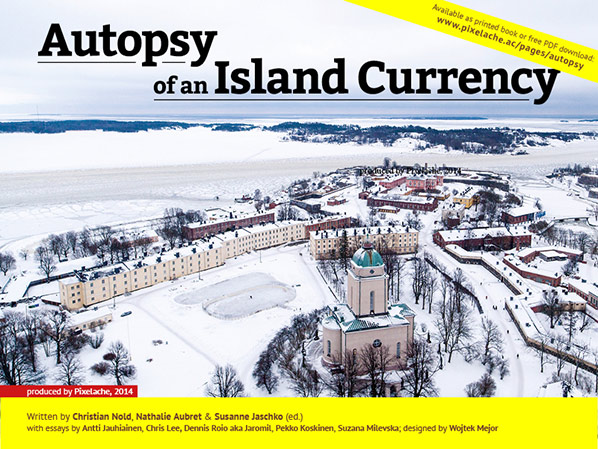
RC: For instance Christian Nold led a show-and-tell at the second session, based on a book, Autopsy of an Island Currency (2014) that he had worked on with Nathalie Aubret and Susanne Jaschko. The book problematises a project called Suomenlinna Money Lab, a participatory art and design project that worked with money and local currencies as a social and artistic medium and that sought to involve a community of people in a critique of its own economies. This reinforced for me the contribution that situated practices have to make to theories of the commons, as the book tells a revealing story of resistance to critique in a place and community with an established interest and investment in the cultures associated with private ownership.
TW: Nevertheless there were a lot of times when people ‘looked pained’, because basically we had just jumped in and started discussing the idea of the commons without realising that we were all speaking with different understandings of basic terms. In other words, we were all operating on different registers that sprang from our hailing from different philosophical and disciplinary roots and traditions. It might have benefited us to begin by trying to map out our terms. On the other hand, this might have prevented us from ever even starting! This mapping, perhaps, is a project that we need to figure out how to undertake.
RC: The difficulty of wrangling different registers was also exacerbated by the seemingly unbounded scope of the discussion. The relatively recent growth of the World Wide Web introduces enough material for months of readings about how the digital commons has helped to shift thinking about the commons away from merely the management of material resources to knowledge and cultural work.
Still, we felt – perhaps because Furtherfield’s physical venues are located within a public park – a sense of urgency to think about the social layers of physical and digital space in relation to the commons, as a way to resist the unquestioning total commercialisation of all realms.
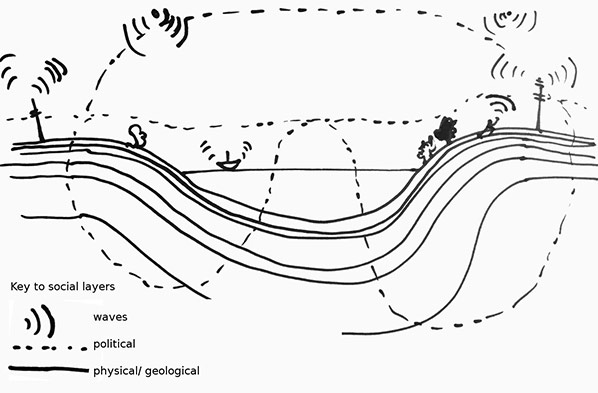
RC: To take a couple of steps back….There are misconceptions about the commons that require rectification. Political economist Elinor Ostrom showed, in opposition to Garrett Hardin, that in theory and in practice, the collective co-operative management of shared socio-ecological resources was a lived reality in many localities (1990). While her research drew on management of material resources her Eight Design Principles for Common Pool Resources, shares many characteristics with digital commons.
Hardin’s (1968) essay “The Tragedy of the Commons” had argued that commonly owned resources were doomed to exploitation and depletion by private individuals; therefore justifying the role of hierarchical, centralised systems of power to maintain private ownership. On the other hand, Jeremy Gilbert in his book Common Ground (2013), quotes radical economist Massimo de Angelis, to define the commons as social spheres which help protect us from the market. This becomes particularly useful to help us to recalibrate our definitions of “free” and “sharing” as we reveal so much of our private lives (so nonchalantly) via ubiquitous, proprietary digital devices and commercial social platforms.
TW: Hardin’s one-dimensional projection of the commons as unworkable and disastrous was based upon an understanding of human relations that assumed that competitive individualism is ‘human nature’ and that all such ‘experiments’ were doomed to failure as a result. This is Darwin’s survival of the fittest rendered as ‘dog eat dog’. The voice almost contemporary with Darwin’s that I think most clearly articulates how evolution (human and otherwise) is based upon cooperation is Peter Kropotkin’s, in his amazing book Mutual Aid (1902). Evolutionary science and theory is moving ever more towards Kropotkin’s conclusions rather than Darwin’s, or at least Kropotkin’s work is becoming ever more relevant and complementary to Darwin’s. For me, it’s also impossible to imagine how cultural evolution could work at all except through the cooperation, sharing, and processes of negotiation that characterise the commons.
The landscape commons has always been about more than just material resources, and this is perhaps the most reductively oversimplified register on which we might speak of the commons. So if the problem is to align the different and more meaningful registers along which we all discuss the commons so that a truly collective and collaborative project can emerge amongst many disciplines simultaneously, we should have a go at pinning in place a few core understandings of the commons? Shall we give that a go?
RC: Yes! From my work with Furtherfield, my feeling for the commons is strongly influenced by the cultures of freedom and openness in engineering and software. In 2011 we created a collection of artworks, texts and resources about freedom and openness in the arts in the age of the Internet. “Freedom to collaborate – to use, modify and redistribute ideas, artworks, experiences, media and tools. Openness to the ideas and contributions of others, and new ways of organising and making decisions together.”[3]
If we can agree that the commons are those resources that are collectively produced and managed by, and in the interests of, the people who use them, then the digital commons, as set out by Felix Stalder, are the technologies, knowledge and digital cultural resources that are communally designed, distributed and owned : wikis, open-source software and licensing, and open cultural works and knowledge repositories.[4] Licences such as the GNU General Public License and various Creative Commons licenses ensure that the freedom to use, adapt and distribute works produced collectively is preserved for the future.
Discussions of the commons have, in the liberal tradition, centred around how to produce, manage and share scarce material resources in a bounded geographical locality. This is fundamentally changed in the post-industrial, information age, where cultural and knowledge goods can be easily, cheaply and quickly copied, shared worldwide and transformed. It has brought about a massive shift in the way economics, politics and law are practiced.
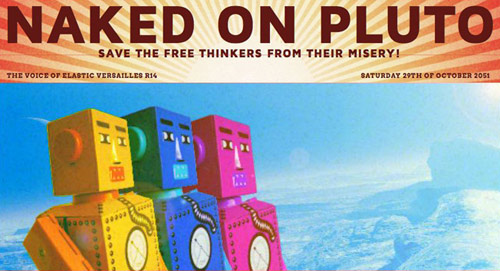
As distinct from the users of the majority of corporately-owned search, sales and social media utilities (think Google, Amazon, Paypal, Facebook, Twitter) and digital entertainment platforms (think Netflix, iMusic and Spotify) the community of people involved in developing the digital commons ‘can intervene in the design and governance of their interaction processes and of their shared resources’ (Stalder) – think Wikipedia, Freesound, Wikihouse. This has long continued to be an area of intense critical inquiry, unfolding, and practice for artists who are creating digital and networked artworks that take the form of platforms, software, tools and interventions such as : Upstage software for online “cyberformance”; Naked on Pluto, an online game whose ‘players’ become unwitting agents in the invasion of their own and others’ privacy ; and PureDyne, the USB-bootable GNU/Linux operating system for creative multimedia.
Consumer cultures invite us constantly to outsource responsibility for knowledge, information and cultural works to the markets. Artists and technologists involved in the digital commons make these otherwise abstract (and often invisible) shifts in power and social relations “feelable” for more people. In this way they are asserting alternatives to the prevailing economic models – often privileging collaboration and free expression that disrupt outmoded models of copyright and intellectual property.[5]
Discussions about the role of affect in the development of the commons will be the subject of the next explorations of Reading the Commons, and we will certainly come back to these.
TW: Let’s look at this from another direction. In landscape terms, the idea of the commons has evolved a great deal over time, as, for example, feudal forms gave way to different hierarchical forms based in capitalism and private property, and now in late capitalism and neoliberalism’s adaptation to, and cooptation of various forms of horizontality, especially in managerial practices. The importance of the commons has also shifted from defining notions of shared ownership and management of agrarian resources to include various manifestations of urban life, most recently and compellingly, perhaps, in the dogmatically horizontal democratic organisation amongst participants in the Occupy movement.

Ultimately, the commons, for me, is about dialogue, sharing, and the relationship between people and place. The earliest expressions of the commons were all about our relationship with food; its procurement, preparation, and consumption. A beautiful historic example is the importance of the chestnut tree to the inhabitants of the Cévennes in southern France, and how it not only embodied the commons, but symbolised it as well. It’s not possible to romanticise this story, as it’s one of very hardscrabble survival, but it does illustrate the point. As a staple food, the chestnut was a matter of survival for the inhabitants of the Cévennes. It would seem, metaphorically, that the idea of rootedness would follow naturally from this as a characteristic of the commons, but the reality is more nuanced. Chestnuts were introduced to the Cévennes by the Romans, and then tended centuries later by monks, who would share plants with the peasants with the expectation of future tithes. Labour-intensive chestnut orchards were farmed not just by locals, but by migrant workers as well. If we fast-forward to the 1960s, chestnuts were rediscovered by those wishing to get ‘back to the land’, reviving agricultural practices that had withered away during the years that capitalism had lured people from the countryside into towns.
This shows a very complex picture of the commons: one in which colonization and imperialism, monasticism, peasantry, migrant labour, and then finally arcadian anti-capitalist mythologies of the 1960s each play a part – and I’m skipping over a lot of historic detail and nuance. There is a tendency nowadays to see the commons as exclusively autonomous and horizontal, but historically the commons have been inextricably bound to patterns of ownership and domination. Far from discounting the commons, this shows how the commons can exist within and exert pressure against prevailing forms of domination and ownership. We need not wait for total revolution or the construction of utopia or arcadia. We can get to work now and make a shining example of what is possible, making use of existing networks and existing places. The anthropologist David Graeber, in his book The Democracy Project, (2014) calls this ‘prefigurative politics’: the idea that by acting out the model of politics and human association and inhabitation that we wish to see, that we work to bring it about.
RC: Yes, and while sociality, rootedness and affinity are all associated with embodied experience, they bubble up again and again in the critical and activist media art community who take digital networks for their tools, inspiration and context. Take for example the Swedish artist/activist group Piratbyrån (The Bureau of Piracy) established in 2003 to promote the free sharing of information, culture and intellectual property. Their entire 2014 exhibition of online and physical installations at Furtherfield Gallery highlighted the centrality to their work of cultural sharing and affinity-building.[6] In his recent conversation with Tatiana Bazzichelli about networked disruption and business, Marc Garrett discusses the importance of affinities in evolving more imaginative, less oppositional (and macho) engagement with regressive forces; and quoting Donna Haraway says “Situated knowledges are about communities, not isolated individuals.”(Haraway 1996).[7]

But Tim, I think you were on a roll. Why don’t you keep going? Why is the commons important now?
TW: The exploitation of people and resources that marks the practices of contemporary capitalism is very much a continuation of the project of the enclosures, whether it is to skim value off creative projects, to asset-strip the public sector which is increasingly encroached upon by the private sector, or to exhaust land and oppress workers in the Third World. The commons, however, are being created continually, and they represent not just a resource to be enclosed and exploited, but a form of resistance that has particular power because it is lived and acted. It’s not at all a contradiction to say that what is common is simultaneously enclosed, exploited, and liberatory. It’s a matter of tipping the balance so that the creation of the commons outpaces its negation.
RC: As people negotiate systems for renewal and stewardship of the resources over time they also arrive at an expression of creative identity and shared values.
TW: A moral economy …
RC: By freely surrendering all collectively created culture, from use value for conversion to exchange value, our shared ecologies of knowledge, culture and land are dismantled.
And with this we stand to lose the ability to attend to the nature of co-evolving, interdependent entities (human and non-human) and conditions, for the healthy evolution and survival of our species.[8]
We are seeing a resurgence of collective and collaborative efforts. Our ongoing DIWO (Do It With Others) campaign[9] sets out to adopt the verve and tactics of DIY culture, but to move us on from its individualism towards imaginative and experimental artistic collaboration. We construct more varied social relations (than those set up by pure market exchange) into the proliferation of connected sensing, communication and knowledge tools, in order to facilitate new forms of trans-global relations and cooperation. Most exciting is the Robin Hood Asset Management Cooperative[10],an activist hedge fund (and the project of economists, critical theorists, artists and financial experts) which distributes shares to members and its profits are invested in pro-social and commons-focused cultural projects.
TW: The point about use value is an important one. Capitalism, in the familiar equation, seeks to convert use value into exchange value. This process abstracts and simplifies value into purely financial terms. The language and action of the commons resists this because it is so often emplaced and embodied. The commons are local, experienced, shared, and negotiated, and they exist within networks of friendship, family, and civil society, which operate as moral economies, not purely monetary ones. I should probably also make the point that the Greek root of the word ‘moral’ signifies custom – which suggests that morals exist in the relational realm of everyday life, rather than in abstract ‘higher’ realms or in abstract financialised realms such as ‘the market’ – and that ‘economy’ comes from Greek again, the oikos, or household. Another firmly embodied and situated idea that is also incontrovertibly relational.
RC: The digital is becoming embodied and situated in a number of ways. Where once the boundaries between the worlds of atoms and bits were marked by screens and passwords, chips and implants are now on or in our bodies, devices and appliances. People and things are becoming increasingly expressive as nodes in the machineweb. Again, this gives artists a vital role in making these effects more legible, feelable and visible. Our actions are tracked, our utterances and exchanges are monitored, and our behaviours inform the design of future media, systems and products. This is the cybernetic loop.[11] We also see a growing awareness of the geo-political questions surrounding the physical infrastructure of the Internet and its role in global markets. The problematisation of the web through heated debates about ownership and control of infrastructure and data, privacy and surveillance expressed in the SOPA debates- the Edward Snowden affair; Tim Berners-Lee’s campaign for a Magna Carta for the web; calls for a Digital Bill of Rights; the development of decentralising blockchain technologies that underpin Bitcoin, Etherium and (many other projects; artistic projects with a Situationist verve such as those of Piratbyran and F.A.T Lab- these all help us to clarify our place, the opportunities and limits for agency and action as we straddle the physical and digital layers.
So then we come back to the question of resistance and the commons. If, as you’ve described above, the continued project of the enclosures sets the scene for new acts of resistance, how Tim do you see these acts taking place in landscape space?
TW: The fact that democracy and the commons both take place (literally a historic act is situated by its taking place) by occupying space as well as by initiating dialogues and negotiations is important. Occupying digital space is important, as you have shown Ruth, and resisting the forms of surveillance and control that seek to close down the digital commons. I take hope from the fact that even if it takes generations to end capitalism, or at least to shift it from a form of global governance to a competitive economic system more appropriate to the scale of the farmers’ market, that the commons will never be fully enclosed, because capitalism is dependent upon the commons to create value that it then marketises and financialises.
Defending the digital commons also occupies physical space. It will be, from time to time, necessary to occupy the streets and squares of our cities in protest to stand up for them. In doing so we stand up for the physical commons at the same time. Governments have all sorts of tools against public demonstrations, such as the British government’s recently renewed hostility to trade unionism and its desire to further limit strike powers. Strikes will happen whether they’re legal or not though, as history amply demonstrates. Often many instances of land occupations are seen to have failed, however they have to have succeeded, at least temporarily, to register in the historical record as symbolic moments. These moments have immense power. The Diggers, for example, followers of Gerrard Winstanley, were proto-anarchists who organised horizontally in their land occupation in Surrey, Northamptonshire, and Buckinghamshire in the mid-1600s. Their planting of vegetables on common land, though a brief experiment, lives on powerfully in the discourses of democracy.
More modern incarnations of this power include the access to land gained by the mass trespass at Kinder Scout, the long-term encampment at Greenham Common, and the incredibly powerful and highly visible symbolism of the Occupy movement in various places from New York to London to Istanbul and beyond. A recent echo of the Diggers is the occupation of Grow Heathrow, which seeks to prevent the airport’s expansion by peacefully living on land proposed for a third runway and growing food there.
RC: So our next steps both for Reading the Commons and in our acting out of the commons are to define and map, for the purposes of resistance in the ongoing creation of commons; digital collaborocracy and an exploration of affect, agency, embodiment and the commons. Creative practices under capitalism have long contained elements of both creation and resistance (or defence), and now these actions, both positive and negative, take place across the digital and situated realms as well as what might now be termed the ‘situated digital’.
TW: I’m pursuing ideas of what Kate Soper calls ‘alternative hedonism’ so that sustainability can be conceived of as joyful. I think satisfaction – the fulfillment of desire – can have radical transformative potential for prosperity as a collective pursuit and is perhaps the only way to tip the balance away from liberal and neoliberal individualist competitive models. My idea of the commons and commoning includes freedom, democracy, nice cups of tea, evenings spent drinking wine and talking, the elimination of poverty, and the flourishing of human habitat and human potential.
RC: Let’s all drink to that!
Many thanks to Professor Jeremy Strong and Dr Penny Travlou for their feedback and notes on this text!
Axelrod, Robert (1984), The Evolution of Cooperation, Basic Books, 2006
Barnes, Peter. (2001) Who Owns The Sky? Our Common Assets and the Future of Capitalism, Island Press
Bauwens, Michel. (2013) Class and Capital in Peer Production.
Bauwens, Michel. (2005)The political economy of peer production. http://www.informatik.uni-leipzig.de/~graebe/Texte/Bauwens-06.pdf
Benkler, Yochai. (2011) The Penguin and the Leviathan: How Cooperation Triumphs Over Self-Interest.
Boal, Iain. The Long Theft: Episodes in the History of Enclosure (forthcoming)
Bollier, David. Think Like a Commoner: A Short Introduction to the Life of the Commons and/or Viral Spiral. How the Commoners Built a Digital Republic of Their Own. New York, London, New Press, 2008 http://www.learcenter.org/pdf/ViralSpiral.pdf
Caffentzis, George. (1973) “Introduction to the New Enclosures” in Midnight Oil: Work, Energy, War.
Clare, John. (1827) From ‘April’, The Shepherd’s Calendar http://www.johnclare.info
DEFRA. (2003) Countryside and Rights of Way Fact Sheets http://adlib.everysite.co.uk/adlib/defra/content.aspx?doc=63428&id=63430
De Angelis, Massimo. (2003) ‘Reflections on alternatives, commons and communities’ http://www.commoner.org.uk/deangelis06.pdf
De Angelis, Massimo and Stavrides, Stavros. (2010) ‘On the Commons: A Public Interview with Massimo De Angelis and Stavros Stavrides’ http://www.e-flux.com/journal/on-the-commons-a-public-interview-with-massimo-de-angelis-and-stavros-stavrides/
Dragona, Daphne. (2013) ‘Artists as commoners in the years of indebtedness’ http://ludicpyjamas.net/wp/?page_id=815
Federici, Silvia. (2004) Caliban and the Witch: Women, the Body, and Primitive Accumulation (Book) http://libcom.org/files/Caliban%20and%20the%20Witch.pdf
Gilbert, Jeremy. (2013) Common Ground – Democracy and Collectivity in an Age of Individualism
Goldsmith, Oliver. (1770) ‘The Deserted Village’ http://www.poetryfoundation.org/poem/173557
Graeber, David. (2013) ‘A Practical Utopian’s Guide to the Coming Collapse’ http://thebaffler.com/salvos/a-practical-utopians-guide-to-the-coming-collapse
Haraway, Donna. (1983) ‘The Ironic Dreams of a Common Language for Women in the Integrated Circuit’ http://www.egs.edu/faculty/donna-haraway/articles/donna-haraway-the-ironic-dream-of-a-common-language-for-women-in-the-integrated-circuit/
Hardin, Garrett. (1968) The Tragedy of the Commons http://www2.geog.ucl.ac.uk/~mdisney/teaching/tutorials/hardin_1968.pdf
Harvey, David. Rebel Cities (2013) http://mappingthecommons.wordpress.com/2012/11/13/the-creation-of-the-ur…
Hyde, Lewis. Common As Air: Revolution, Art, and Ownership. 2010
Kropotkin, Peter. Mutual Aid and/or Fields, Factories and Workshops Tomorrow. 1898 http://www.complementarycurrency.org/ccLibrary/Mutual_Aid-A_Factor_of_Evolution-Peter_Kropotkin.pdf
Lessig, Lawrence. Code and Other Laws of Cyberspace.1999 http://codev2.cc/download+remix/Lessig-Codev2.pdf
Lessig, Lawrence. (2004) Free Culture http://www.free-culture.cc/freeculture.pdf
Linebaugh, Peter. The Magna Carta Manifesto: Liberties and Commons for All. Berkeley: University of California Press, 2008 http://provisionaluniversity.files.wordpress.com/2012/12/peter-linebaugh-the-magna-carta-manifesto-liberties-and-commons-for-all-2008.pdf
Linn, Karl. “Reclaiming the Sacred Commons” and/or Building Commons and Community. Oakland: New Village Press, 2007 http://nccommunitygarden.ncsu.edu/Karl-Linn-ReclaimingTheSacredCommons.pdf
Marx, Karl. (1844) Private Property and Communism. http://www.marxists.org/archive/marx/works/1844/manuscripts/comm.htm
Massey, Doreen. (1994) A Global Sense of Place http://www.unc.edu/courses/2006spring/geog/021/001/massey.pdf
Merchant, Carolyn. (2006) The Scientific Revolution and the Death of Nature http://nature.berkeley.edu/departments/espm/env-hist/articles/84.pdf
Morris, William. News From Nowhere 1893. http://www.sfu.ca/~poitras/Morris_News-from=Nowhere.pdf
Mumford, Lewis. (1964) Authoritarian and Democratic Technics http://www.nyu.edu/projects/nissenbaum/papers/authoritarian.pdf
Nold, Christian and van Kranenburg, Rob. (2011) The Internet of People for a Post-Oil World. http://www.situatedtechnologies.net/?q=node/108
Olwig, Kenneth. (2002) Landscape, Nature, and the Body Politic. University of Wisconsin Press. http://avblivinglandscape.files.wordpress.com/2011/01/olwig_1996.pdf http://dlc.dlib.indiana.edu/dlc/bitstream/handle/10535/77/commons_and_landscape.pdf?sequence=1
Ostrom, Elinor. (2010) “Beyond Markets and States: Polycentric Governance of Complex Economic Systems,” American Economic Review, 100(3), pp. 641-72.
Ostrom, Elinor and Hess, Charlotte, Eds. Understanding Knowledge as a Commons: From Theory to Practice. The MIT Press, Cambridge, Massachusetts, 2006.
Ostrom, Elinor. Governing the Commons. 1990 http://wtf.tw/ref/ostrom_1990.pdf
Ostrom, Elinor, and Gardner, Roy, and Walker, James, Eds. Rules, Games, and Common Pool Resources. Ann Arbor, University of Michigan Press, 1994
Platt, John. Platt, J. (1973). “Social Traps”. American Psychologist 28 (8): 641–651. doi:10.1037/h0035723.
Rexroth, Kenneth. (1974) “Communalism: From Its Origins to the Twentieth Century” http://www.bopsecrets.org/rexroth/communalism2.htm
Sennett, Richard. (2012) Together: The Rituals, Pleasures & Politics of Cooperation.
Ward, Colin. (2012) Talking Green or ‘Play as an Anarchist Parable’ from Anarchy in Action. http://libcom.org/files/Ward_-_Anarchy_in_Action_3.pdf
Winstanley, Gerrard (1649). A Declaration from the Poor Oppressed People of England http://www.bilderberg.org/land/poor.htm
Choose Your Muse is a series of interviews where Marc Garrett asks emerging and established artists, curators, techies, hacktivists, activists and theorists; practising across the fields of art, technology and social change, how and what has inspired them, personally, artistically and culturally.
Annie Abrahams was born in the Netherlands to a farming family in a rural village in the Netherlands. In 1978 she received a doctorate in biology and her observations on monkeys inspired her curiosity about human interactions. After leaving an academic post she trained as an artist and moved to France in 1987, where she became interested in using computers to construct and document her painting installations. She has been experimenting with networked performance and making art for the Internet since the mid 1990s. Her works have been exhibited and performed internationally at institutions such as the National Museum of Modern Art in Tokyo, New Langton Arts in San Francisco, Centre Pompidou in France, Academy of Fine Arts in Helsinki and many other venues.
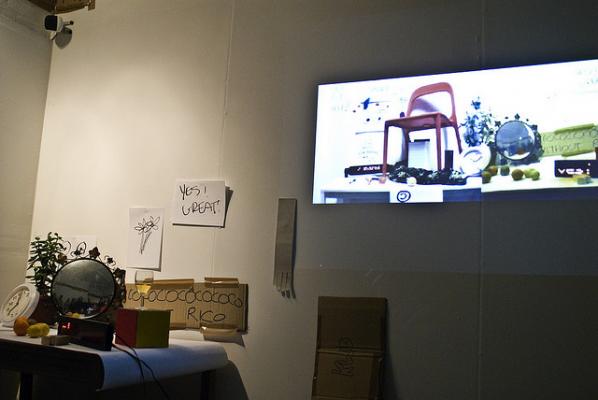
Through the years we have got to know Annie Abrahams via various online, networked artistic collaborations. In 2010, she had a her first one woman show If not you not me in the UK at Furtherfield’s earlier gallery space, the HTTP Gallery. Since then, she has shown at another mixed show at Furtherfield’s current space in Finsbury Park, London. This exhibition, Being Social included other artsists such as Karen Blissett, Ele Carpenter, Emilie Giles, moddr_ , Liz Sterry, and Thomson and Craighead.

She is known worldwide for her net art and collective writing experiments and is internationally regarded as a pioneer of networked performance art. She creates situations that reveal messy and sloppy sides of human behaviour; capturing real-time moments to illucidate a reality and opening it up, making it available for thought. In an interview with Bomb Magazine in 2014 Abrahams said “My first online performance was my first HTML page. Even then I considered the Internet to be a public space, and everything that I did in that public space asked for a reaction.” [1]
Marc Garrett: Could you tell us who has inspired you the most in your work and why?
Annie Abrahams: Life itself, the people I meet. Until now my basic needs in life have hardly been threatened and so the only real problems I encountered were relational problems. Who are you? Why are you different from me? What does it mean to respect you? Is opposing you necessary? And if so, how can I do that?
MG: How have they influenced your own practice and could you share with us some examples?
AA: My practice was always based on the difficulty of having to live in a world where I don’t understand anything. Every person I meet opens up another view on this impossibility. Sometimes I write short posts about my encounters. Lately I did one on Shirley Clarke and one on Ed Atkins’ No-one is more “Work” than me. aabrahams.wordpress.com
MG: How different is your work from your influences and what are the reasons for this?
AA: My work is made from these influences. In the beginning I thought this was not ok, because I was educated with the idea that you have to be “unique” and make unique artworks. But now I am proud of my sensibility for what others say and do and the way I work with that.

MG: Describe a real-life situation that inspired you and then describe a current idea or art work that has inspired you?
AA: Last summer I made a book called from estanger to e-stranger. Ruth Catlow described it as “all-at-once instruction manual, poetry and a series of vignettes of contemporary encounters in language-less places”. There you can find ideas and art works that inspire me, but in general I am not driven by inspiration, my acts are driven by irritation, my art by incomprehension. Art works sooth, make things bearable and sometimes incite to look beyond habits. Btw I am still continuing my research on how language shapes culture, society and me. http://e-stranger.tumblr.com/
MG: What’s the best piece of advice you can give to anyone thinking of starting up in the fields of art, technology and social change?
AA: Stay close to your own concerns, to things you can have a concrete influence on, observe the results of your actions, pay attention, adapt, and always smile to your neighbour in the morning.

MG: Could you recommend any reading materials or exhibitions past or present that you think would be great for readers to view, and if so why?
AA: For years now every now and then I’ve come back to Darren O’Donnell’s book “Social Acupuncture” and always again I say to myself, “yes, you can think and act art and politics together. Please have a look at the Mammalian Diving Reflex group’s (he is their artistic director) methods. http://mammalian.ca/method/
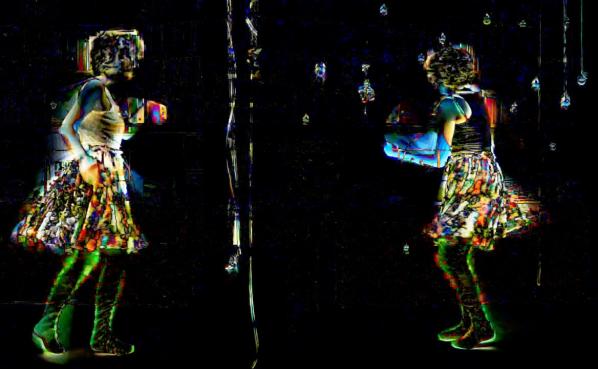
For over 17 years, Furtherfield has been working in practices that bridge arts, technology, and social change. Over these years, we have been involved in many great projects and collaborated with and supported various talented people. Our artistic endeavours include net art, media art, hacking, art activism, hacktivism and co-curating. We have always believed it is essential that the individuals at the heart of Furtherfield practice in arts and technology and are engaged in critical enquiry. For us, art is not just about running a gallery or critiquing art for art’s sake. The meaning of art is in perpetual flux, and we examine its changing relationship with the human condition. Furtherfield’s role and direction as an arts collective is shaped by the affinities we identify among diverse independent thinkers, individuals and groups who have questions to ask in their work about the culture.
Here I present a selection of Furtherfield projects and exhibitions featured in the public gallery space we have run in Finsbury Park in North London for the last two years. I set out some landmarks on the journey we have experienced with others and end my presentation with news of another recently opened space (also in the park) called the Furtherfield Commons.
Running themes in this presentation include how Furtherfield has lived through and actively challenged the disruptions of neoliberalism. The original title for this presentation was ‘Artistic Survival in the 21st Century in the Age of Neoliberalism’. The intention was to stress the importance of active and open discussion about the contemporary context with others. The spectre of neoliberalism has paralleled Furtherfield’s existence, affecting the social conditions, ideas and intentions that shape the context of our work: collaborators, community and audience. Its effects act directly upon ourselves as individuals and around us: economically, culturally, politically, locally, nationally and globally. Neoliberalism’s panoptic encroachment on everyday life has informed Furtherfield’s motives and strategies.
In contrast with most galleries and institutions that engage with art, we have stayed alert to its influence as part of a shared dialogue. The patriarch, neoliberalism, de-regulated market systems, corporate corruption and bad government; each implement the circumstances where we, everyday people, are only useful as material to be colonized. This makes us all indigenous peoples struggle under the might of the wealthy few. Hacking around and through this impasse is essential if we maintain human integrity and control over our social contexts and ultimately survive as a species.
“The insights of American anarchist ecologist Murray Bookchin into environmental crisis hinge on a social conception of ecology that problematises the role of domination in culture. His ideas become increasingly relevant to those working with digital technologies in the post-industrial information age, as big business develops new tools and techniques to exploit our sociality across high-speed networks (digital and physical). According to Bookchin, our fragile ecological state is bound up with a social pathology. Hierarchical systems and class relationships so thoroughly permeate contemporary human society that the idea of dominating the environment (to extract natural resources or to minimise disruption to our daily schedules of work and leisure) seems perfectly natural despite the catastrophic consequences for future life on earth (Bookchin 1991). Strategies for economic, technical and social innovation that focus on establishing ever more efficient and productive systems of control and growth, deployed by fewer, more centralised agents, have been shown to be both unjust and environmentally unsustainable (Jackson 2009). Humanity needs new social and material renewal strategies to develop more diverse and lively ecologies of ideas, occupations and values.” [1] (Catlow 2012)
It is no longer critical, innovative, experimental, avant-garde, visionary, evolutionary, or imaginative to ignore these large issues of the day. Suppose we, as an arts organization, shy away from what other people are experiencing in their daily lives and do not examine, represent and respect their stories. In that case, we rightly should be considered part of an irrelevant elite and seen as saying nothing to most people. Thankfully, many artists and thinkers take on these human themes in their work in various ways, on the Internet and in physical spaces. So much so, this has introduced a dilemma for the mainstream art world regarding its relevance and whether it is contemporary.
Furtherfield has experienced, in recent years, a large-scale shift of direction in art across the board. And this shift has been ignored (until recently) by mainstream art culture within its official frameworks. However, we need not only to thank the artists, critical thinkers, hackers and independent groups like ours for making these cultural changes, although all have played a big role. It is also due to an audience hungry for art that reflects and incorporates their social contexts, questions, dialogues, thoughts and experiences. This presentation provides evidence of this change in art culture, and its insights flow from the fact that we have been part of its materialization. This is grounded knowledge based on real experience. Whether it is a singular movement or multifarious is not necessarily important. But, what is important is that these artistic and cultural shifts are bigger than mainstream art culture’s controlling power systems. This is only the beginning, and it will not go away. It is an extraordinary swing of consciousness in art practice forging other ways of seeing, being, thinking, making and becoming.
Furtherfield is proud to have stuck with this experimental and visionary culture of diversity and multiplicity. We have learned much by tuning into this wild, independent and continuously transformative world. On top of this, new tendencies are coming to the fore, such as re-evaluations and ideas examining a critical subjectivity that echo what Donna Haraway proposed as ‘Situated Knowledge’ and what the Vienna-based art’s collective Monochrom call ‘Context Hacking’. Like the DADA and the Situationist artists did in their time, many artists today are re-examining current states of agency beyond the usually well-promoted, proprietorial art brands, controlling hegemonies and dominating mainstream art systems.
Most Art Says Nothing To Most People.
“The more our physical and online experiences and spaces are occupied by the state and corporations rather than people’s own rooted needs, the more we become tied up in situations that reflect officially prescribed contexts, and not our own.” [2]

To start things off, I want to refer to a past work that Heath Bunting (co-founder of irational.org) and I were involved with in 1991. The above image is a large paste-up displayed on billboards around Bristol in the UK. At the time, as well as being part of other street art projects, pirate radio and BBS boards, Heath and I and others were members of the art activist collective Advertising Art. The street art we made critiqued presumed ownership of art culture by the dominating elites. The words “Most Art Says Nothing To Most People” have remained an inner mantra ever since.
Furtherfield is inspired by ideas that reach for a grassroots form of enlightenment and nurture progressive ideas and practices of social and cultural emancipation. The Oxford English Dictionary describes Emancipation as “the fact or process of being set free from legal, social, or political restrictions; liberation: the social and political emancipation of women and the freeing of someone from slavery.”
“Kant thought that Enlightenment only becomes possible when we are able to reason and to communicate outside of the confines of private institutions, including the state.” [3] (Hind 2010)

Well, a start would be getting organised and building something valuable with others.
As usual, it is up to those people who know that something is not working and those feeling the brunt of the issues affecting them who end up trying to change the conditions. It is unlikely that this pattern of behaviour will change.
To expect or even wish those who rule and those serving them to change, challenge their behaviours and seriously critique their actions is as likely as winning the National Lottery, perhaps even less.
Art critic Julian Stallabrass proposes that there needs to be an analysis of the operation of the art world and its relation to neoliberalism. [4]

In the above publication, Gregory Sholette argues “that imagination and creativity in the art world thrives in the non-commercial sector, shut off from prestigious galleries and champagne receptions. This broader creative culture feeds the mainstream with new forms and styles that can be commodified and utilized to sustain the few elite artists admitted into the elite. […] Art is big business: a few artists command huge sums of money, and the vast majority are ignored, yet these marginalized artists remain essential to the mainstream cultural economy serving as its missing creative mass. At the same time, a rising sense of oppositional agency is developing within these invisible folds of cultural productivity. Selectively surveying structures of visibility and invisibility, resentment and resistance […] when the excluded are made visible when they demand visibility, it is always ultimately a matter of politics and rethinking history.” [5] (Sholette 2013)
Drawing upon Sholette’s inspirational, unambiguous and comprehensive critique of mainstream art culture in the US. I want to consider examples closer to home blocking artistic and social emancipation avenues that also need an urgent critique. And this blockage resides within media art culture (or whatever we call it now) itself. Recently, I read a paper about ‘Post-Media’ – said to “unleash new forms of collective expression and experience” [6]- which featured in its text-only established names. Furtherfield is native to ‘Post-Media’ processes, a concept that theorists in media art culture are just beginning to grasp. This is because they tend to rely on particular theoretical canons and the defaults of institutional hierarchies to validate their concepts. Also, most of the work they include in their research is shown in established institutions and conferences. They assume that because a particular artwork or practice is accepted within the curatorial remits of a conference theme, the art shown represents what is happening, thus more valid than other works and groups not included. This is a big mistake. It only reinforces the conditions of a systemic, institutionalised, privileged elite and enforces a hierarchy that will reinforce the same myopic syndromes of mainstream art culture. The extra irony here is that many supposedly insightful art historians and theorists advocate a decentralised, networked culture in their writings or as a relational context. However, many do not support or create alternative structures with others. The real problem is how they acquire their knowledge. Presently the insular and hermetically sealed dialectical restraints and continual reliance on central hubs as official reference is distancing them from the actual culture they propose to be part of.
“We must allow all human creativity to be as free as free software” [7] (Steiner, 2008)
Furtherfield comes from a cultural hacking background and has incorporated into its practice ideas of hacking not only with technology but also in everyday life. Furtherfield is one big social hack. Hack Value advocates an art practice and cultural agency where the art includes the mechanics of society as part of its medium and social contexts with deeper resonances and a critical look at the (art) systems in place. It disrupts and discovers fresh ways of looking and thinking about art, life and being. Reclaiming artistic and human contexts beyond the conditions controlled by elites.
Hack Value can be a playful disruption. It is also maintenance for the imagination, a call for a sense of wonder beyond the tedium of living in a consumer, dominated culture. It examines crossovers between different fields and practices concerning their achievements and approaches in hacking rather than as specific genres. Some are political, and some are participatory. This includes works that use digital networks, physical environments, and printed matter. What binds these examples together is not only the adventures they initiate when experimenting with other ways of seeing, being and thinking. They also share common intentions to loosen the restrictions, distractions and interactions dominating the cultural interfaces, facades and structures in our everyday surroundings. This relates to our relationship with food, tourism, museums, galleries, our dealings with technology, belief systems and community ethics.
Donna Haraway proposes a kind of critical subjectivity in the form of Situated Knowledges.
“We seek not the knowledges ruled by phallogocentrism (nostalgia for the presence of the one true world) and disembodied vision. We seek those ruled by partial sight and limited voice – not partiality for its own sake but, rather, for the sake of the connections and the unexpected openings situated knowledges make possible. Situated knowledges are about communities, not isolated individuals.” [8] (Haraway 1996)
Furtherfield had run [HTTP], London’s first public gallery for networked media art, since 2004 from an industrial warehouse in Haringey. In 2012 the gallery moved to a public location at the McKenzie Pavilion in the heart of Finsbury Park, North London.
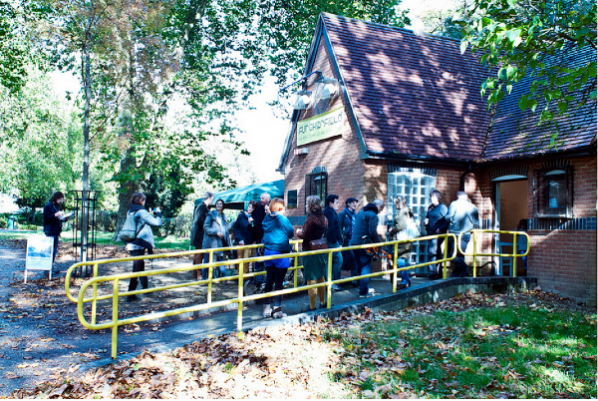
However, we are not just a gallery; we are a network connecting beyond a central hub.
“It is our contention that by engaging with these kinds of projects, the artists, viewers and participants involved become less efficient users and consumers of given informational and material domains as they turn their efforts to new playful forms of exchange. These projects make real decentralised, growth-resistant infrastructures in which alternative worlds start to be articulated and produced as participants share and exchange new knowledge and subjective experiences provoked by the work.” [9] (Garrett & Catlow, 2013)
The park setting informs our approach to curating exhibitions in a place with a strong local identity, a public green space set aside from the urban environment for leisure and enjoyment by a highly multicultural population.

We are simultaneously connected to a network of international critical artists, technologists, thinkers and activists through our online platforms, communities, and wider networked art culture. We get all kinds of visitors from all backgrounds, including those who do not normally visit art spaces. We are not interested in pushing the mythology of high art above other equally significant art practices. Being accessible has nothing to do with dumbing down. It concerns making an effort to examine deeper connections between people and the social themes affecting theirs and our lives. We don’t avoid big issues and controversies and constantly engage in a parallel dialogue between these online communities and those meeting us in the park.
We feature works incorporating local people’s contributions, bringing them closer to the art and engagement of social dialogue. For instance, London Wall, N4 by Thomson and Craighead, reflected a collective stream of consciousness of people all around Finsbury Park, gathering their Tweets to print out and paste onto the gallery walls. By retweeting the images of the tweet posters, we gathered many of the original authors in the gallery to see their words physically located among others made in the vicinity.
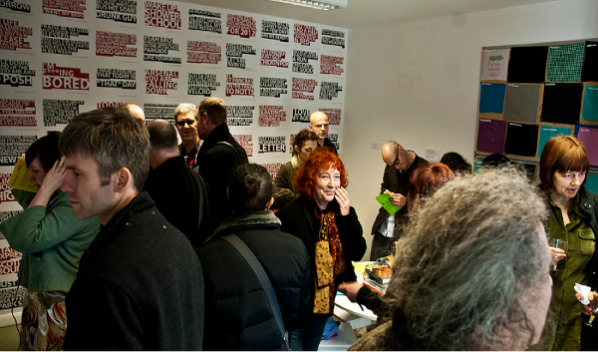
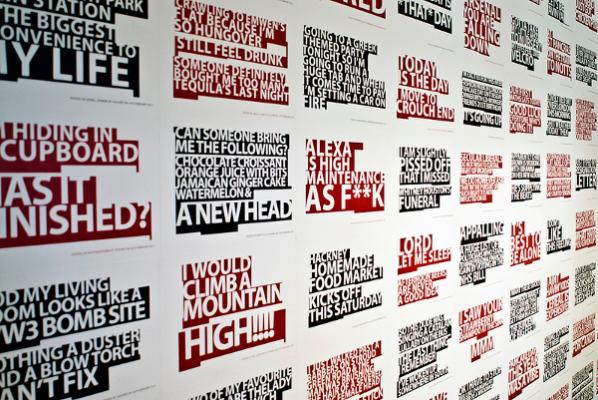
Crow_Sourcing by Andy Deck invited people to tweet animal expressions from around the world – illuminating the link between the formation of human language and our relationships with other wild webs of animal life. Gallery visitors illustrated their animal idioms, drawing directly onto the gallery walls, inspired by the ducks, crows, squirrels and dogs that inhabit the park.
We feature works dealing with networked and pervasive technologies’ human and social effects. Web 2.0 Suicide Machine by moddr_ proposed an improvement to our ‘real’ lives by providing a one-click service to remove yourself, your data, and your profile information forever from Facebook, Twitter and MySpace, replacing your icon (again, forever) with a logo depicting a noose. They also reflect on new forms of exposure and vulnerabilities they give rise to, such as Kay’s Blog, by Liz Sterry, which replicated in physical space the unkempt bedroom of an 18-year-old Canadian girl based only on her blog posts, to eerie effect. The intention is to reach people in a way that has people question their relationship with those technologies. This does not mean promoting technology as a solution to art culture but exploiting it to connect with others and critique technologies simultaneously.
Below: Selection of images from original slide presentation – exhibitions & events.
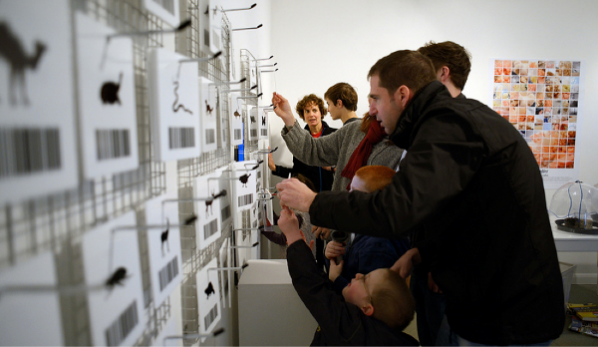


On the 23rd of November, we opened our second space in the park, ‘The Furtherfield Commons’. It kicked off with The Dynamic Site: Finsbury Park Futures, an exhibition by students from the Writtle School of Design (WSD) featuring ideas and visions for future life in Finsbury Park, coinciding with the launch.
This new lab space for experimental arts, technology and community explores ways to establish commons in the 21st Century. It draws upon influences from the 1700s when everyday people in England, such as Gerrard Winstanley and collaborators, forged a movement known as the Diggers, the True Levellers, to reclaim and claim common land from the gentry for grassroots, peer community interests. Through various workshops, residencies, events & talks, we will explore what this might mean to people locally and in connection with our international networks. These include free software works, critical approaches to gardening, gaming and other hands-on practices where people can claim direct influence in their everyday environments in the physical world, to initiate new skills and social change on their terms. From what we have learned from our years working with digital networks, we intend to apply tactical skills and practices into everyday life.
Furtherfield is a network across different time zones, platforms & places – online & physical, existing as various decentralised entities. A culture where people interact: to create, discuss, critique, review, share information, collaborate, build new artworks & alternative environments (technological, ecological, social or both), examine & try out value systems. “A rhizome has no beginning or end; it is always in the middle, between things, interbeing, intermezzo.” (Brian Massumi 1987)
DADA, Situationism, punk, Occupy, hacktivism, networks, Peer 2 Peer Culture, feminism, D.I.Y, DIWO, Free Software Movement, independent music labels, independent thinkers, people we work with, artists, activism, grassroots culture, community…
This comprises technological and physical forms of hacking. It also includes aspects and actions of agency-generation, skill, craft, disruption, self-education, social change, activism, aesthetics, re-contextualizing, claiming or reclaiming territories, independence, emancipation, relearning, rediscovering, play, joy, being imaginative, criticalness, challenging borders, breaking into and opening up closed systems, changing a context or situation, highlighting an issue, finding ways around problems, changing defaults, and restructuring things – Claiming social contexts & artistic legacies with others!
This text is a re-edited slide presentation first shown at the ICA, London, UK, on 16th November 2013 (Duration 25 min). Intermediality: Exploring Relationships in Art. Speakers Katrina Sluis, Peter Ride, Sean Cubitt & Marc Garrett.
http://www.ica.org.uk/39077/Talks/Intermediality-Exploring-Relationships-in-Art.html
Transdisciplinary Community (TDC) Leicester UK 27th Nov 2013 (45 min). Institute of Creative Technologies. De Montfort University.
Two projects Gregory Sholette is currently involved in:
It’s the Political Economy, Stupid. Curated by Oliver Ressler & Gregory Sholette
http://gallery400.uic.edu/exhibitions/its-the-political-economy-stupid
Matt Greco & Greg Sholette | Saadiyat Island Workers Quarters Collectable, 2013
http://bit.ly/1eSI5kX
—————————————————–
All exhibitions, events & projects at Furtherfield – http://www.furtherfield.org/programmes/exhibitions
Jonas Lund’s “The Fear Of Missing Out” (2013) is a series of gallery art objects made by the artist following the instructions of a piece of software they have written. It has gained attention following a Huffington Post article titled “Controversial New Project Uses Algorithm To Predict Art “.
Art fabricated by an artist following a computer-generated specification is nothing new. Prior to modern 2D and 3D printing techniques, transcribing a computer generated design into paint or metal by hand was the only way to present artworks that pen plotters or CNC mills couldn’t capture. But a Tamagotchi-gamer or Amazon Mechanical Turk-style human servicing of machine agency where a program dictates the conception of an artwork for a human artist to realize also has a history. The principles involved go back even further to the use of games of chance and other automatic techniques in Dada and Surrealism.

What is novel about The Fear Of Missing Out is that the program dictating the artworks is doing so based on a database derived from data about artworks, art galleries, and art sales. This is the aesthetic of “Big Data“, although is not a big dataset by the definition of the term. Its source, and the database, are not publicly available but assuming it functions as specified the description of the program in the Huffington Post article about it is complete enough that we could re-implement it. To do so we would scrape Art Sales Index and/or Artsy and pull out keywords from entries to populate a database keyed on artist, gallery and sales details. Then we would generate text from those details that match a desired set of criteria such as gallery size and desired price of artwork.
What’s interesting about the text described in the Huffington Post article is that it’s imperative and specific: “place the seven minute fifty second video loop in the coconut soap”. How did the instruction get generated? Descriptions of artworks in artworld data sites describe their appearance and occasionally their construction, not how to assemble them. If it’s a grammatical transformation of scraped description text that fits the description of the project, but if it’s hand assembled that’s not just a database that has been “scraped into existence”. How did the length of time get generated? If there’s a module to generate durations that doesn’t fit the description of the project, but if it’s a reference to an existing 7.50 video it does.
The pleasant surprises in the output that the artist says they would not have thought of but find inspiring are explained by Edward de Bono-style creativity theory. And contemporary art oeuvres tend to be materially random enough that the randomness of the works produced looks like moments in such an oeuvre. Where the production differs both from corporate big data approaches and contemporary artist-as-brand approaches is that production is not outsourced. Lund makes the art that they use data to specify.

Later, the Huffington Post article mentions the difficulty of targeting specific artists. A Hirst artwork specification generator would be easy enough to create for artworks that resemble his existing oeuvre. Text generators powered by markov chains were used as a tool for parodying Usenet trolls, and their strength lies in the predictability of the obsessed. Likewise postmodern buzzword generators and paper title generators parody the idees fixes of humanities culture.
The output of such systems resembles the examples that they are derived from. Pivoting to a new stage in an artist’s career is something that would require a different approach. It’s possible to move, logically, to conceptual opposites using Douglas Hofstadter’s approaches. In the case of Hirst, cheap and common everyday materials (office equipment) become expensive and exclusive ones (diamonds) and the animal remains become human ones.

This principle reaches its cliometric zenith in Colin Martindale’s book “The Clockwork Muse: The Predictability of Artistic Change”. It’s tempting to dismiss the idea that artistic change occurs in regular cycles as the aesthetic equivalent of Kondratieff Waves as Krondatieff Waves are dismissed by mainstream economics. But proponents of both theories claim empirical backing for their observations.
In contrast to The Fear Of Missing Out’s private database and the proprietary APIs of art market sites there is a move towards Free (as in freedom) or Open Data for art institutions. The Europeana project to release metadata for European cultural collections as linked open data has successfully released data from over 2000 institutions across the EU. The Getty Foundation has put British institutions that jealously guard their nebulously copyrighted photographs of old art to shame by releasing almost 5000 images freely. And most recently the Tate gallery in the UK has released its collection metadata under the free (as in freedom) CC0 license.
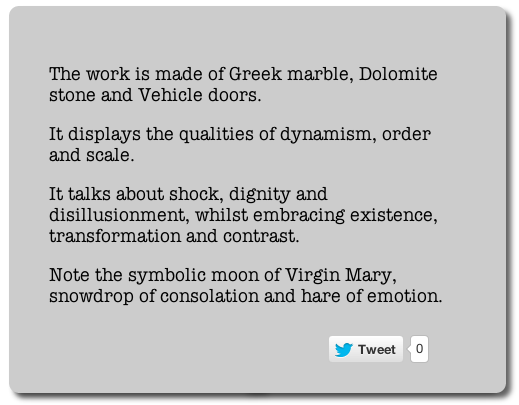
Shardcore’s “Machine Imagined Artworks” (2013) uses the Tate collection metadata to make descriptions of possible artworks. Compared to the data-driven approach of The Fear Of Missing Out, Machine Imagined Artworks is a more traditional generative program using unconstrained randomness to choose its materials from within the constrained conceptual space of the Tate data’s material and subjects ontologies.
Randomness is ubiquitous but often frowned upon in generative art circles. It gives good results but lacks intention or direction. Finding more complex choice methods is often a matter of rapidly diminishing returns, though. And Machine Imagined Artworks makes the status of each generated piece as a set of co-ordinates in conceptual space explicit by numbering it as one of the 88,577,208,667,721,179,117,706,090,119,168 possible artworks that can be generated from the Tate data.
Machine Imagined Artworks describes the formal, intentional and critical schema of an artwork. This reflects the demands placed on contemporary art and artists to fit the ideology both of the artworld and of academia as captured in the structure of the Tate’s metadata. It makes a complete description of an artwork under such a view. The extent to which such a description seems incomplete is the extent to which it is critical of that view.
We could use the output of Machine Imagined Artworks to choose 3D models from Thingiverse to mash-up. Automating this would remove human artists from the creative process, allowing the machines to take their jobs as well. The creepy fetishization of art objects as quasi-subjects rather than human communication falls apart here. There is no there there in such a project, no agency for the producer or the artwork to have. It’s the uncanny of the new aesthetic.
Software that directs or displaces an artist operationalises (if we must) their skills or (more realistically) replaces their labour, making them partially or wholly redundant. Dealing in this software while maintaining a position as an artist represents this crisis but does not embody it as the artist is still employed as an artist. Even when the robots take artists jobs, art critics will still have work to do, unless software can replace them as well.
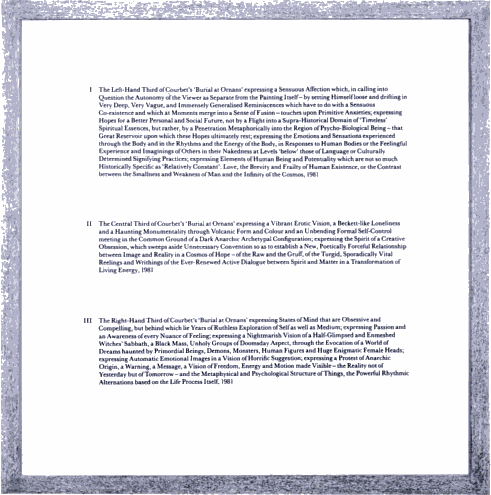
There is a web site of markov chain-generated texts in the style of the Art & Language collective’s critical writing at http://artandlanguage.co.uk/, presumably as a parody of their distinctive verbal style. Art & Language’s painting “Gustave Courbet’s ‘Burial at Ornans’ Expressing…” (1981) illustrates some of the problems that arbitrary assemblage of material and conceptual materials cause and the limitations both of artistic intent and critical knowledge. The markov chain-written texts in their style suffer from the weakness of such approaches. Meaning and syntax evaporate as you read past the first few words. The critic still has a job.

Or do they? Algorithmic criticism also has a history that goes back several decades, to Gips and Stiny’s book “Algorithmic Aesthetics” (1978). It is currently a hot topic in the Digital Humanities, for example with Stephen Ramsay’s book “Reading Machines: Toward an Algorithmic Criticism” (2011). The achievements covered by each book are modest, but demonstrate the possibility of algorithmic critique. The problem with algorithmic critique is that it may not share our aesthetics, as the ST5 antenna shows.
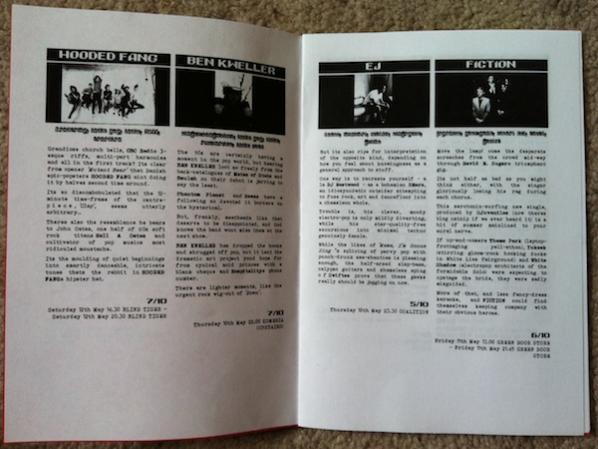
Shardcore’s “Cut Up Magazine” (2012) is a generative critic that uses a similar strategy to “The Fear Of Missing Out”. It assembles reviews from snippets of a database of existing reviews using scraped human generated data about the band such as their name, genre, and most popular songs. Generating the language of critique in this way is subtly critical of its status and effect for both its producers and consumers. The language of critique is predictable, and the authority granted to critics by their audience accords a certain status to that language. Taken from and returned to fanzines, Cut Up Magazine makes the relationship between the truth of critique, its form, and its status visible to critique.
We can use The Fear Of Missing Out-style big data approaches to create critique that has a stronger semantic relationship to its subject matter. First we scrape an art review blog to populate a database of text and images. Next we train an image classifier (a piece of software that tells you whether, for example, an image contains a Soviet tank or a cancer cell or not) and a text search engine on this database. Then we use sentiment analysis software (the kind of system that tells airlines whether tweets about them are broadly positive or negative) to generate a score of one to five stars for each review and store this in the database.
We can now use this database to find the artworks that are most similar in appearance and description to those that have already been reviewed. This allows us to generate a critical comment about them and assign them a score. Given publishing fashion we can then make a list of the results. The machines can take the critic’s job as well, as I have previously argued.
What pieces like The Fear Of Missing Out and Machine Imagined Artworks make visible is an aspect of How Things Are Done Now and how this affects everyone, regardless of the nature of their work. This is “big data being used to guide the organization”. To regard such projects simply as parody or as play acting is to take a literary approach to art. But art doesn’t need to resolve such ontological questions in order to function, and may provide stronger affordances to thought if it doesn’t. What’s interesting is both how much such an approach misses and how much it does capture. As ever, art both reveals and symbolically resolves the aporia of (in this case the Californian) ideology.
The text of this review is licenced under the Creative Commons BY-SA 3.0 Licence.
Featured image: UBERMORGEN, CCTV, A Parallel Universe, (2013)
Rachel Falconer’s article is written in response to an interview conducted with lizvlx and Hans Bernhard from Ubermorgen. ‘userunfriendly’ is their first solo exhibition in London and presents a performative study of creeping paranoia. It is on show at Caroll/Fletcher Gallery through October until 16th November 2013.
“You one of those right wing nut outfits?” inquired the diplomatic Metzger. Fallopian twinkled. “They accuse us of being paranoids.” “They?” inquired Metzger, twinkling also. “Us?” asked Oedipa. The Crying of Lot 49 [1]
The Edward Snowden soap opera is far from over as the media and social commentators continue to perform a one-way polylogue with the absconded, muted Snowden. The furore and essentialist reactions directed towards Snowden, the latest in a burgeoning breed of leaky information gatekeepers, has resulted in a pervading sense of neuroses creeping across the digital commons. One of the many media stunts to emerge from this backdrop of encroaching paranoia was Kevin Poulsen’s encrypted open letter to Snowden on the Wired website [2] . With the theatrical opening gambit of: “Don’t read this if you aren’t him”, this mimetic conceptual poke served only to simulate a tunnel vision debate about the authenticity of the encryption, and several bravado attempts to crack the PGP key.
The Snowden case is symptomatic of our current condition of post-panoptic surveillance, whereby practices of data and behavior tracking have led to an extension of Foucault’s panoptic theories beyond the notion of hierarchical surveillance. Recent debates about post-panoptic practices indicate a shift from direct, embodied surveillance, to distributed, mobile surveillance manifested in the likes of PRISM, XKeystore and Tempra. The normalization of the “need to watch and be watched” generated by our information society is ruptured in this instance by Snowden.
The combination of public outcry – exemplified by the recent anti-surveillance march in Washington – and the intensified interest in the phenomenon of mass surveillance on the hype cycle, has resulted in a number of workshops and art exhibitions dedicated to “giving the power back to the people”. Eyebeam recently hosted PRISM Breakup [3], a three-day event programme of workshops and talks which sought to offset the publically perceived imbalance in our mutual surveillance society by making the tools of the anti-surveillance trade accessible to everyone. This strategy of using the ecology of the art institution as an alternative site of knowledge production, and a locus of retreat and pedagogical resistance, is well rehearsed in the history of contemporary art. However, by concentrating on providing the tools of counteraction against the omnipresent, invisible, panoptic enemy of surveillance, perhaps the bigger picture of the phenomena of neurotic binarisms and shifting psychological territories are in danger of being overlooked.
In contrast to these oppositional tactics, the artists and digital actionists, UBERMORGEN, approach phenomena such as Snowden, and other symptoms of perceived hyper-capitalism from a fuzzier, more ambiguous subjectivity. In their quest for knowledge production and social dialogue, the artists present and re-present the conditions of our global socio-political situation as physical and ephemeral catalysts of open-ended investigation. Through their encounter with the digital, they craft physical manifestations of data, acting as a mobile research unit producing knowledge about real life conditions that spike their interest. Their widely questioned claim to neutrality is defended in their Manifesto; they are very specific about their position as actionists as opposed to activists, and place the physicality of the human body and neurological system at the core of their practice: “we are not activists. we are actionists in the communicative and experimental tradition of viennese actionism – performing in the global media, communication and technological networks, our body is the ultimate sensor and the immediate medium”.[4]
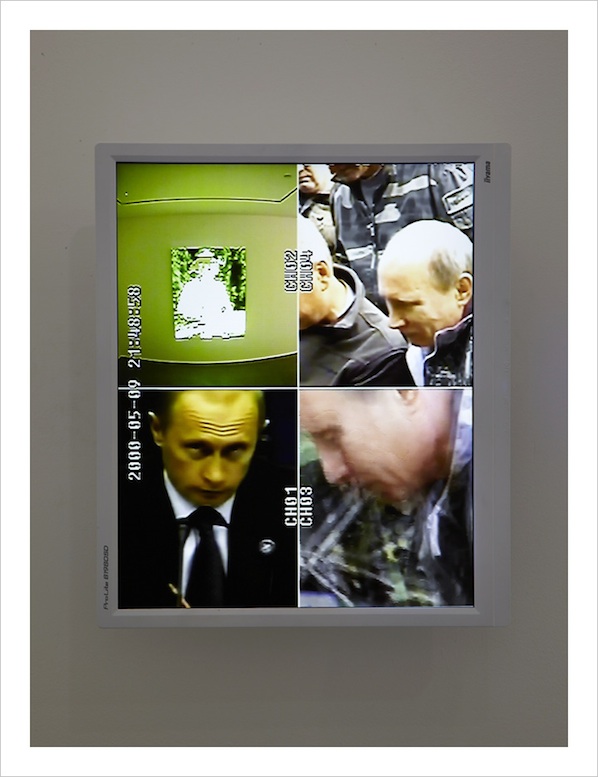
This position of political evasion hinges on a willful abstraction, and distancing from, their chosen subject matter. They activate this abstraction through their instinctive aesthetic strategy, creating a distance from the negative connotations popularly attributed to their subject matter by the media. The work Vladimir (2013) is a clear example of this obfuscating, poetic tactic the duo employ. Here, a CCTV monitor is split into four separate screens and located on the first floor of the gallery space. One screen shows the actual painting of Putin, (located in the lower gallery space). This takes the form of a pixelated painted canvas of Putin onto which an animated GIF is projected. Another screen from the CCTV plays footage of Putin at a press conference. On the remaining screens, there are images displaying alternative subjectivities of how Putin sees himself: heroic of the leader with a naked torso whilst partaking in the popular macho pursuits of fishing and shooting. These images are set up to relate to the animated canvas located and distanced in the lower gallery space. The relational dynamics between the works create a fragmented picture of the subject’s identity, and, as lizvlx suggests, this sense of abstraction and distancing through the aesthetics employed, neutralizes any characteristic of evil popularly associated with the subject himself. The viewer is left to come to an independent conclusion.
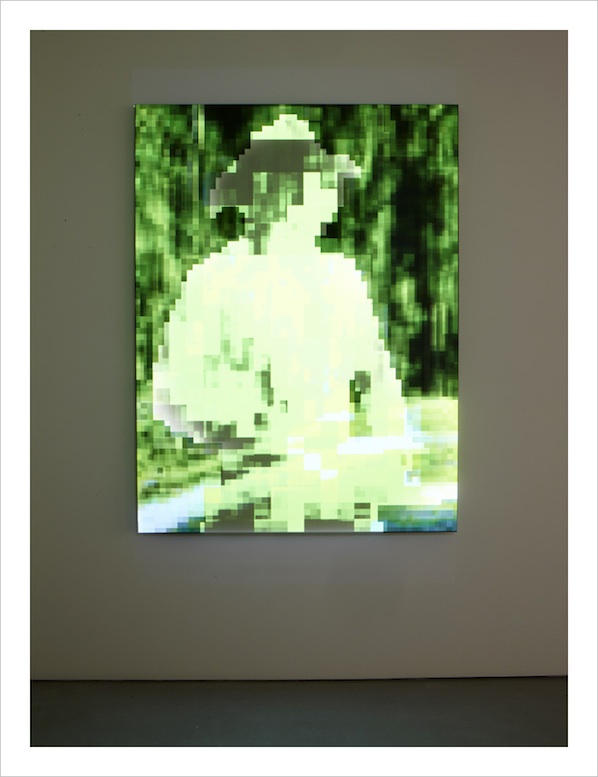
In fact, the entire show is a tightly choreographed relational synthesis. As I experience Hans and lizvlx’s all-encompassing Gesamtkunstwerk , I get the distinct, and unnerving impression that I am being watched. Call me paranoid if you will, but as I navigate through the show, I can’t help but notice that the familiar white cube space is punctuated and peppered by an abundance of CCTV cameras, staged situations of observation, identity –skewing overblown pixels, Crime Watch images and performative interrogation environments, placing the user cum visitor in an uncanny feedback loop of reactionary surveillance.

UBERMORGEN’s collaboration with Aram Bartholl, Net.Art (2013), is the first work I encounter as I enter the gallery. Bartholl’s OFFLINE ART [5] curatorial strategy takes the form of five wall mounted routers locally broadcasting a selection of UBERMORGEN’s net.art pieces disconnected from the Internet. These hermetically-sealed works make the visitor aware that they are being choreographed and controlled from the off – initiating the uninitiated and reminding those familiar with their work that it is never a comfortable ride. Bartholl’s new model of exhibition format is a subtle method of instilling a sense of self-awareness in the viewer. Throughout the show, UBERMORGEN continue to stimulate a gradual awareness, and partially expose, the systems of coercion, control mechanisms and surveillance techniques employed by institutions of public authority. As the tectonically-shifting position between fact and fiction continues to play out throughout the show, UBERMORGEN’s empirical probing of corporate and governmental control mechanisms becomes increasingly apparent.
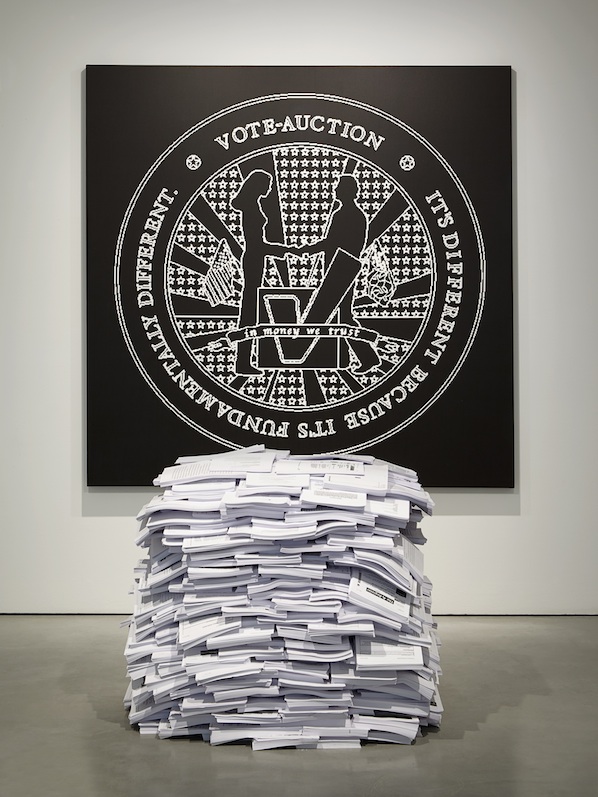
The historic work [V]ote-Auction(2000)- whose virtual subversion resulted in RL FBI intervention- is presented here as an impotent, dormant archive, its stacks of legal documents masquerading as a minimalist sculpture. However, the two new works CCTV(A parallel universe)(2013) and Do You Think That’s Funny? – The Snowden Files (2013) directly implicate the viewer in the act of surveillance. Both pieces are staged situations of observation and temptation. Do You Think That’s Funny is accompanied by a piece of pseudo fan fiction cum interview between UBERMORGEN and Edward Snowden available in the gallery catalogue. The installation itself is a contemplative, yet menacing frieze of control. According to the artists, they are in receipt of an encrypted data package from Snowden. The staged scenario tantalises the viewer/user by offering up Snowden’s dark data on wall-mounted Ethernet cables. A bench is provided for the viewer directly in front of the cables to contemplate the magnitude of their content. This meditative state is rudely interrupted by a looming white CCTV camera fixed to the parallel wall, levelled at the spectator. I am already aware of the presence of this electronic eye having encountered CCTV (A Parallel Universe) (2013), in the previous room. In this piece, the glaringly crisp images on the TV monitor clearly depict the panoptic gaze of the CCTV cameras installed in every part of the gallery, creating an infinite visual feedback loop.

Call me paranoid, but as I navigate the exhibition, I become increasingly self-conscious. White cube galleries usually have the feel of surveyed environments, with their incumbent aura of silent contemplation, lurking invigilators and clearly posed CCTV cameras, but this is a different kind of watching. The fact that the work itself is not the main focus of the all-seeing eye of protection slowly dawns on me, and I feel that I am in fact the star of the show. As I crawl along the tunnel to reach the work Superenhanced (2013), I am aware of the fact that I am enacting a part, and white mice, hamster wheels and men in white coats come to my mind as I glimpse the two chairs and the hand cuffs ahead of me. As I look up and see that my confession can be clearly observed by visitors above me through the upper gallery stairwell, the picture is completed and I take my position in this physical simulation of a video game environment.

UBERMORGEN’s work implicitly involves and implicates both the visitor and themselves in a complex, and increasingly distorted feedback loop of knowledge production and surveillance. It is not, however, the surveillance of the Weiwei-esque, ever-present CCTV camera that starts to destabilise me, but the internal, cognitive surveillance prompted by the ambiguous narrative of the works. As the camera becomes assimilated and internalised, I am compelled to survey myself.
Public Screening and Discussion at Furtherfield
Contact: info@furtherfield.org
Visiting Information
THE EVENT HAS LIMITED AVAILABILITY.
PLEASE RSVP TO BOOK YOUR PLACE TO ALESSANDRA
Cornelia Sollfrank will present her latest film Giving What You Don’t Have. It features interviews with individuals Kenneth Goldsmith, Marcell Mars, Sean Dockray, Dmitry Kleiner, discussing with Sollfrank their projects and ideas on peer-to-peer production and distribution as art practice. It includes the projects ubu.com or aaaaarg.org, which combine social, technical and aesthetic innovation; they promote open access to information and knowledge and make creative contributions to the advancement and the reinvention of the idea of the commons.
The post-screening discussion will be led by Cornelia Sollfrank, Joss Hands & Rachel Baker.
On the basis of the interviews of Giving What You Don’t Have, we would like to discuss some of the issues they represent such as new forms of collaborative production, the shift of production from artefacts to the provision of open tools and infrastructures, the development of formats for self-organisation in education and knowledge transfer, (the potential and the limits of) open content licensing as well as the creation of independent ways of distributing cultural goods. An implicit part of Giving What You Don’t Have is a suggested reconceptualization of art under networked conditions.
Cornelia Sollfrank is a postmedia conceptual artist and interdisciplinary researcher and writer. She studied painting at the Academy of Fine Arts in Munich and fine art at the University of Fine Arts of Hamburg (1987-1994). Since 1998 she has taught at various universities and written on issues in the nexus between media, art and politics. In 2011 Sollfrank completed her practice-led interdisciplinary research at Dundee University (UK) and published her PhD thesis with the title Performing the Paradoxes of Intellectual Property. In addition to her work in the artistic and academic fields, Sollfrank gathered experience in the private sector by working as product manager for Philips Media for two years (1995-1996).
Joss Hands‘ research engages the relationship between media, culture and politics. His recent work has explored the role of digital media in direct action, protest and activism, culminating in his book @ is For Activism: Dissent Resistance and Rebellion in a Digital Culture, published by Pluto Press in 2011. His previous research has explored the role of new media in formal democracy and governance as well as its cultural, economic and social impact. He has published in a number of journals such as Information, Communication and Society, Philosophy and Social Criticism and First Monday as well as writing commentary for publications such as Open Democracy, IPPR Journal, The New Left Project, and others.
Rachel Baker is a network artist who collaborated on the influential irational.org. Her art practice explores techniques used in contemporary marketing to gather and distribute data for the purposes of manipulation and propaganda. Networks of all kinds are “sites” for Baker’s public and private distributed art practice, including radio combined with Internet (Net.radio), mobile phones and SMS messaging, and rail networks. She has presented and exhibited work internationally at various new media and electronic art festivals.
Giving What You Don’t Have is an artistic research project commissioned by the Post-Media Lab, Leuphana University.
Furtherfield Gallery
McKenzie Pavilion, Finsbury Park
London N4 2NQ
T: +44 (0)20 8802 2827
E: info@furtherfield.org
Furtherfield Gallery is supported by Haringey Council and Arts Council England.
Peter Lunenfeld’s book “The Secret War Between Downloading & Uploading: Tales Of The Computer As Culture Machine” (MIT Press 2011) presents a new way of looking at the cultural struggle for control of the Internet. Although the conflict between uploading and downloading may not seem secret since the Napster case a decade ago, and is indeed a common feature of net political debate, Lunenfeld is using the concepts of downloading and uploading to discuss not the copyfight but how human beings relate to each other culturally and socially through technology.
Lunenfeld immediately establishes both technical and poetic meanings for each term. Downloading is fetching data from a central server, or an animal eating. Uploading is sending data to a server and to other devices. It is also animal excretion and nesting, and the human creation of “superfluous” material goods such as paintings and experiences such as philosophy. Downloading for Lunenfeld is consumption, and in its current state dominated by broadcast media it is overconsumption leading to “cultural diabetes” in which mass culture plays the role of high fructose corn syrup (HFCS).
This is vivid, but the very definition of uploading that Lunenfeld starts with (sending data to other devices) also involves downloading (…to other devices). The “slow food” movement that he contrasts with super-sized, HFCS-laden American diets is a product of broadcast culture like any other hipster franchise. And outside the US, HFCS has never replaced sugar and state and independent television has provided an alternative to the HFCS of the brain that he describes network television as. If I am critical of this, and a (very) few of Lunenfeld’s other arguments, it is only because of the clarity with which the rest of them are presented and with which they are all developed. This is a serious, ambitious and forward-looking book about human use of networked computing machinery in an age when cybercultural lullabies and recanting cyberprophets have turned the field into an inward- and backward-looking one. It deserves serious critique.
As the subtitle of the book, “Tales Of The Computer As Culture Machine”, claims the computer, and particularly the networked computer, is indeed a culture machine. Computing machinery can imitate any other machine, and so any mechanically reproducible media (that is to say, all mass media) can be created, distributed and reproduced by computers. That the wide availability of computers and network access changes the balance of power in the media is a common claim, and one that it is easy to view cynically in the face of an Internet of lolcats and conspiracy theory blogs. But Lunenfeld takes us beyond this.
Lunenfeld builds up concepts and weaves them together into a coherent and thought-provoking worldview. Affordances, mindfulness, information triage, sticky vs. teflon objects, tweaking, toggling, continual partial production, unfinish, WYMIWYM, MaSAI. Some of these are standard in cyberculture and its critiques. Others are Lunenfeld’s own coinage. They build up to form a new vocabulary and a conceptual framework for new critical take on network culture. And, crucially, new possibilities for action on the basis of that critique. Like all the best Theory, Lunenfeld’s concepts identify something important in the real world and afford new ways of thinking about it and acting on it.
Having exhorted us to download mindfully through info-triage and to upload meaningfully, to make unimodernist media sticky and unfinished and to move beyond the revolutionary rhetoric of Web 2.0 to an evolutionary Web n.0, Lunenfeld describes a world of bespoke futures (“Creatively misusing scenario planning as a means toward crafting visions of the future”) and plutopian meliorism (the pluralistic pursuit of happiness within an open society).
The ultimate destination that emerges in the final pages of this new take on network culture is surprisingly high stakes. It is nothing less than an appeal to use the means of the aesthetics of the culture machine to pursue the ends of plutopian meliorism in the face of the closures of would-be theocrats and other totalitarians. That is, to use the net to reaffirm the enlightenment in all its ambition and seriousness leavened with and strengthened by the pluralism of postmodernism’s critique of modernity.
Is the framework that Lunenfeld has built up in the course of the book up to this task? Can it be used to address left and right-wing criticism from within and without mainstream Western society that Western culture is just, well, entertainment? Lunenfeld’s achievement is to build his framework from many small measures that can easily be applied practically and evaluated against vivid concepts. By the end of the book you can see how to act on this and to evaluate whether your actions succeed. And the effects of those actions, although not revolutionary (and Lunenfeld rightly points out that the rhetoric of revolution has been appropriated by theocratic and corporate reaction), will be in the direction of considered lives in a society that is more than simply entertainment as a result.
Lunenfeld finishes the main argument of the book by proclaiming that he will write utilities rather than manifestos. But he has written a fine example of both here: a call to action with a conceptual and practical toolkit to support it. With cyberculture at its most nostalgic and despondent at precisely the moment where network culture is showing its potential for both progressive and reactionary political change, the modesty of Lunenfeld’s means and the ambition of his ends are a much needed and easily embraced positive step forwards.
http://mitpress.mit.edu/catalog/item/default.asp?ttype=2&tid=12452
The text of this review is licenced under the Creative Commons BY-SA 3.0 Licence.